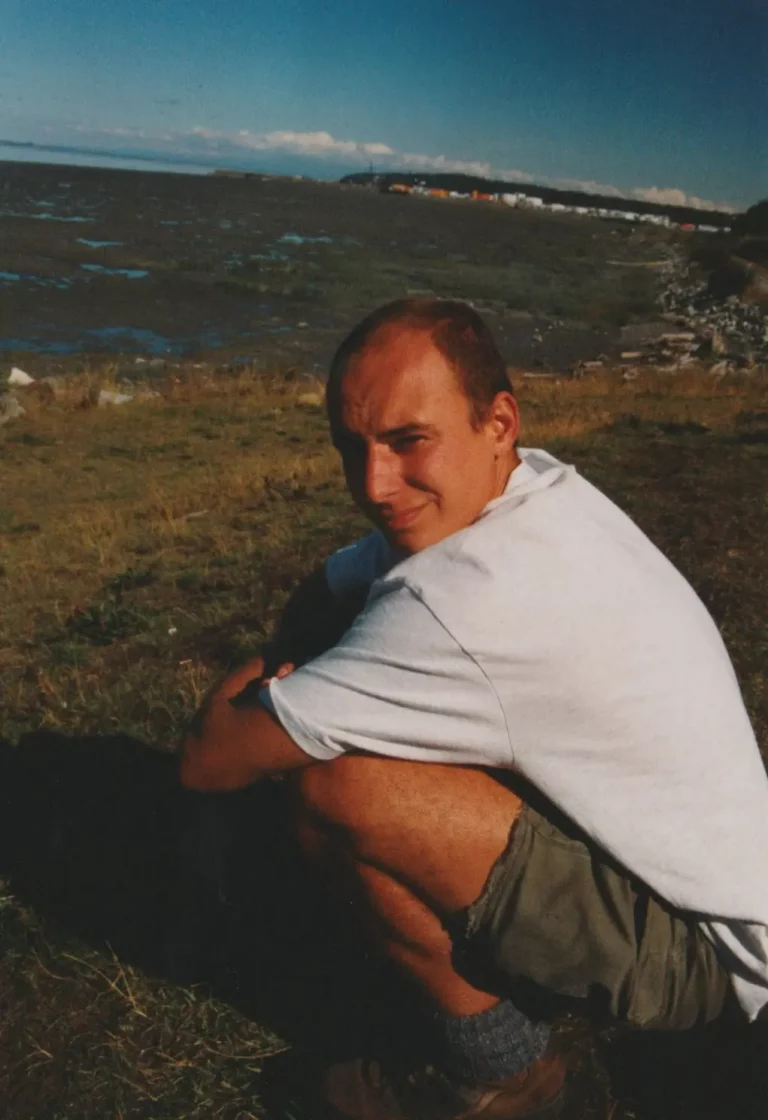In 6 weeks from Juneau via Skagway, Whitehorse, Dawson, Eagle, Fairbanks and Denali National Park to Anchorage
In July and August 1997, my friend Thomas and I went on a 6-week outdoor tour in Alaska.
We had both just completed our military service and had the time and desire for an adventure in North America before studying.
Inspired by the novels of Jack London (Call of the Wild) and on the 100th anniversary of the great gold rush in 1897 on the Klondike in Alaska, we wanted to get to the Klondike on the gold rush route – with a backpack, tent and canoe on the Yukon.
Since we are already in Alaska, we of course also want to go to Denali National Park and be as close to the big Denali as possible.
It should be noted that we planned this tour (as was common back then) without the internet, but with a travel guide and Lonely Planet.
With various uncertainties we started our journey in Munich.
We had the travel agency plan the flight (Munich – Frankfurt – San Francisco – Seattle – Juneau) in a cost-optimized manner. This long flight was the first challenge.

Our journey begins at the airport in Munich at the Beginning of July 1997.
We pack our backpacks in sturdy nylon bags to ensure that our belts and straps arrive in Alaska undamaged.
From Munich via Frankfurt to San Francisco and then via Seattle to Juneau.
That’s a lot of hours of sitting and we are very happy when our luggage arrives with us in Juneau.



From the small airport we take a taxi into the city to buy some supplies and gasoline for our stove. We also book a ferry ticket to get to Skagway two days later.



On the following 2 days we visit the Mendenhall Glacier and spend the night in a tent on the beach and in the forest.
On the very first evening we are curiously examined by our neighbor, the beaver.



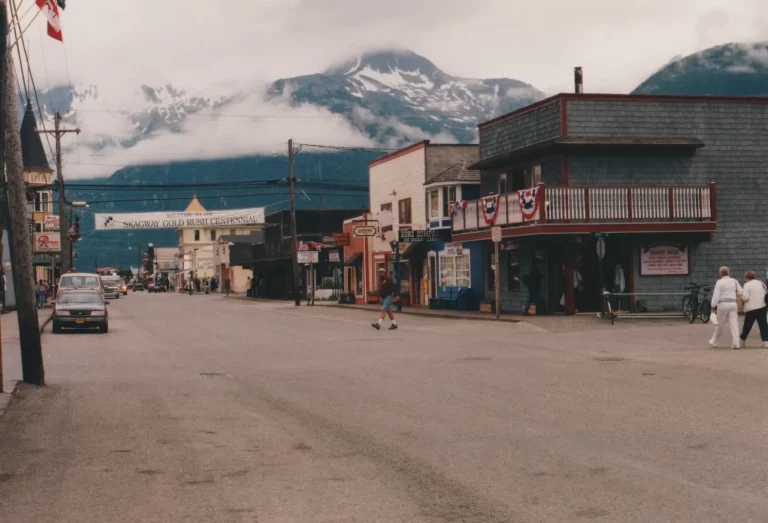
We only stay in Skagway for a short time. Everything here is decorated as part of the 100th anniversary of the gold rush. Skagway is well prepared for tourists and ferry visitors.
We are immediately booking our hiking permit for the Chilkoot Trail because the number of hikers in this area is limited for environmental reasons.
We also receive training on trail behavior because this is black bear territory and the black bears like to share the hiking trail with people.
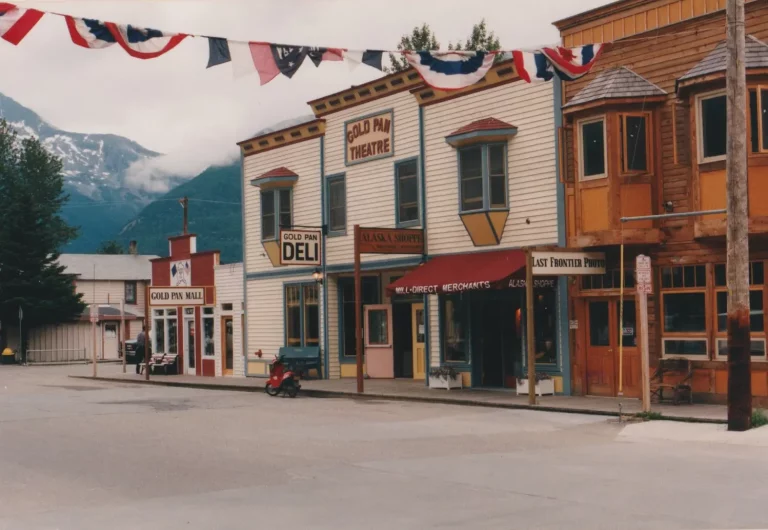
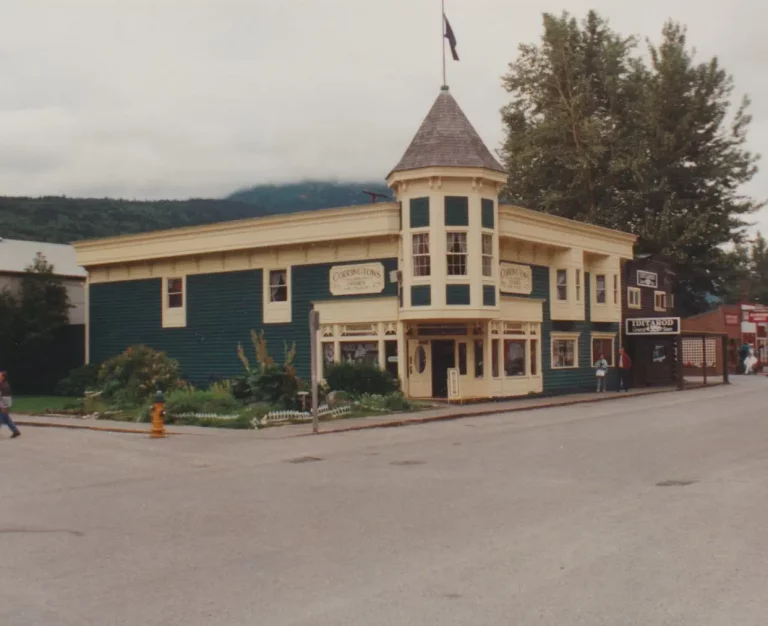


With our hiking permit in your pocket and a hiking map, we set off.
Just in time for the start of our tour, the rainy weather starts. It will stay that way for the next two days.
Our backpack weight is approx. 29kg. It’s not ultralight hiking – but we have everything we need with us – and a little more!




On the second day we reach the Chilkoot Pass via the Dead Horse Trail, over which numerous gold seekers hiked to the Yukon 100 years ago.
We climbed in heavy fog and only thanks to the good markings did we find the right path to the pass.
At the top of the pass there are still many relics of that time (iron stoves, pots, etc.) and all of them are historically listed items.
Legend has it that a piano was even transported over the Chilkoot Pass to a saloon in Dawson City.



A day later, as we descend towards Lake Lindemann, the sun comes out again and beautifully wild nature reveals itself to us.
That makes us happy and we hike calmly and relaxed down into the valley.
A bit too relaxed, as it turns out, because Thomas slips while crossing a river and with the 29kg on his back, a fall into the stream is unavoidable.
Laughing, I catch up with him and help him out of the cold water. Unfortunately, he chipped his upper front tooth when he fell.
Luckily we have some painkillers with us to help him get through the next few days.



From Bennett the route follows the White Pass railway line to Carcross.
The fact that the distance between the railway sleepers doesn’t match our step size at all makes this route a real torture.


After several kilometers of jumping railway sleepers, we finally meet the road to Carcross.
We still have to walk a few kilometers on this road to the next bus stop.
From there we take the bus to Whitehorse.


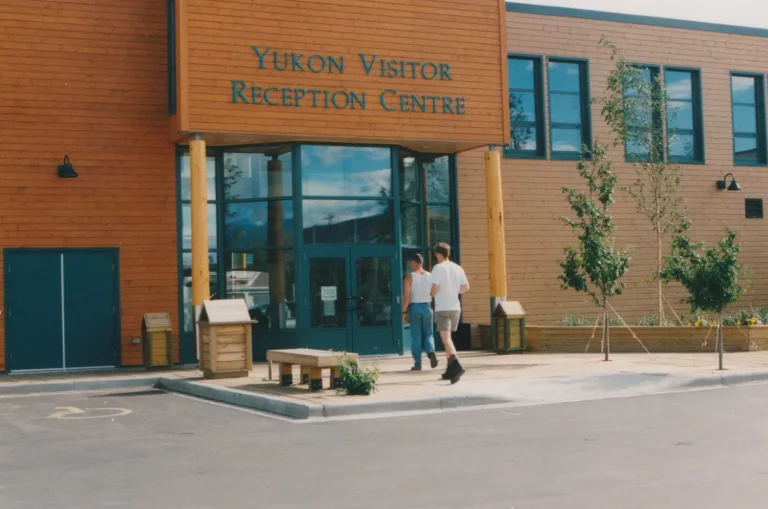
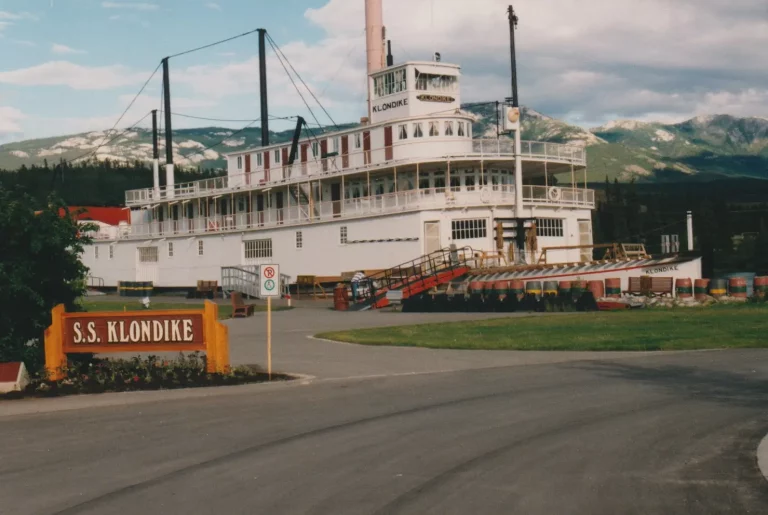
After 4 days we are finally back in civilization in Whitehorse. They are prepared for tourists there and we also visit the paddle steamer S.S. Klondike, which used to transport various goods on the Yukon between Whitehorse and Dawson.
Thomas has his front tooth repaired at the dentist in Whitehorse and thanks to our traveler’s checks and foreign health insurance, that’s not a problem.
At the tourist information center we meet a German family who also want to go to Dawson by canoe.
With Birgit, Thomas (yes, also a Thomas) and their 2-year-old son Lukas, we organize our meals and canoes – also with a German canoe rental company from Münster, which always runs a canoe rental in Alaska over the summer.
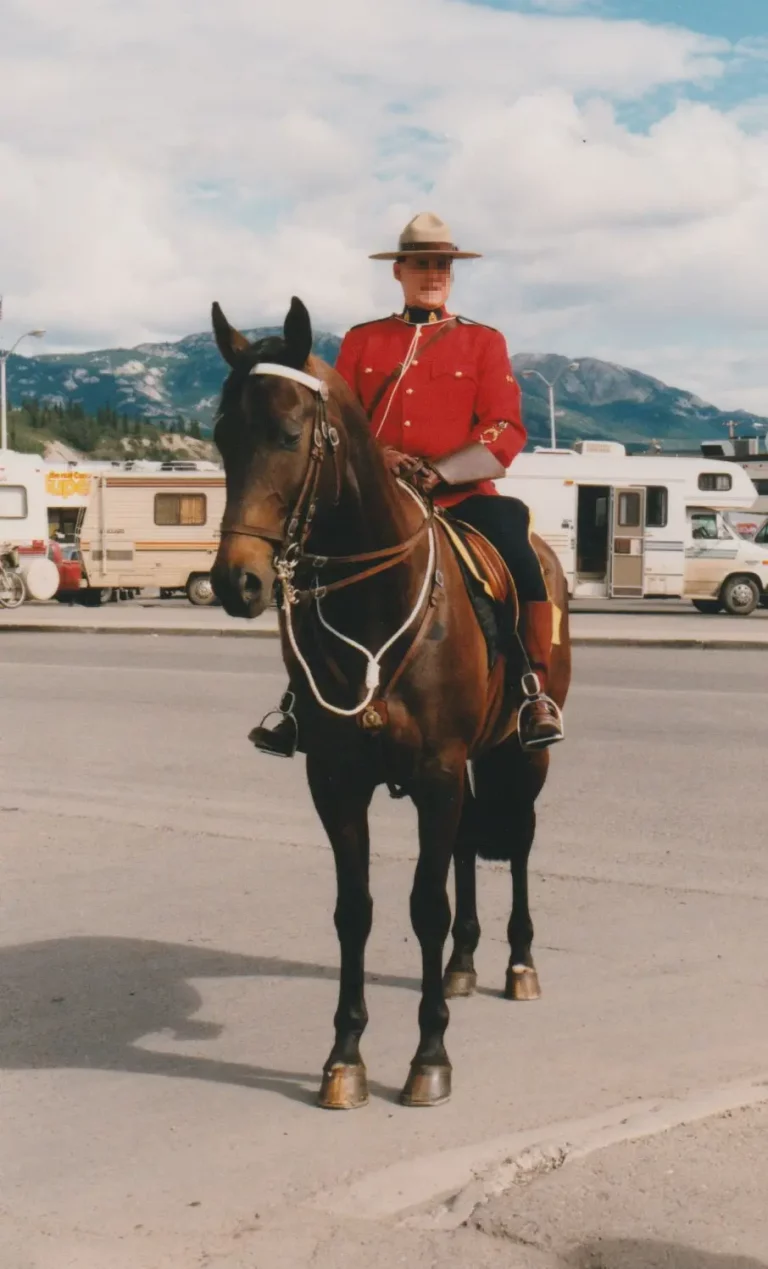
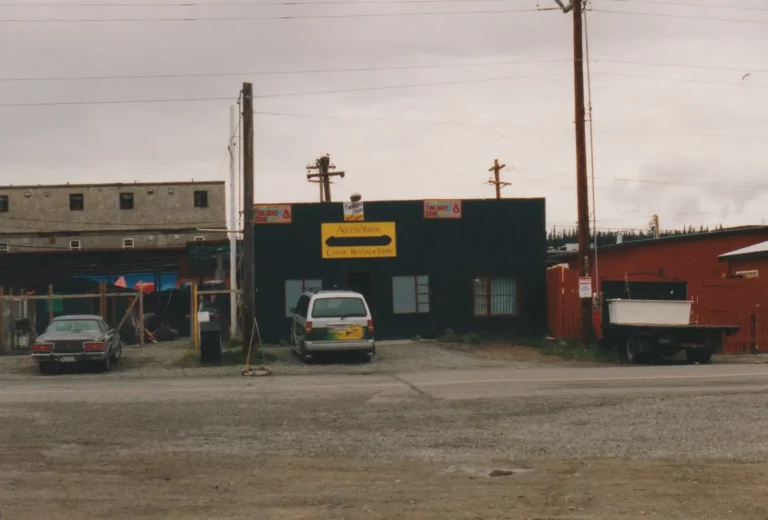
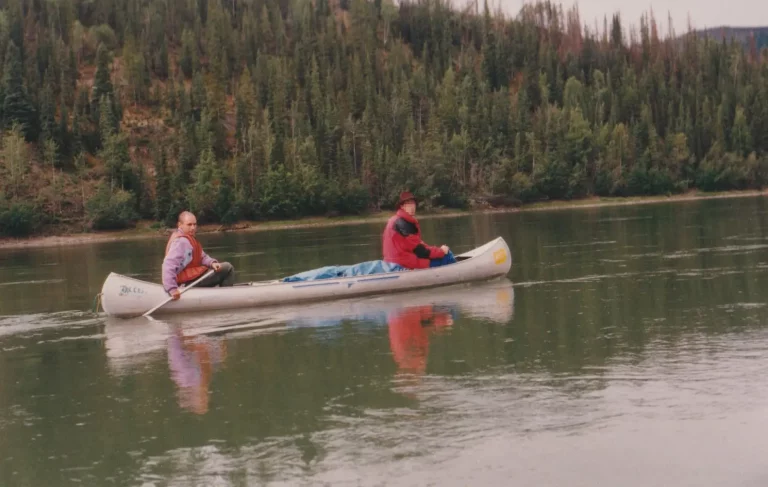
In windy weather we set off in our canoes from Whitehorse on the Yukon towards the Klondike – the destination of all gold diggers.
At Lake Laberge the wind blows through the valley and so we quickly convert our canoe into a sailboat.
After about a third of the way across the lake, the waves get so high that we stop driving and look for a suitable place to spend the night.
A day later we arrive in Lower Labarge, where we leave the lake behind us and share our camp with many tame and hungry ground squirrels.
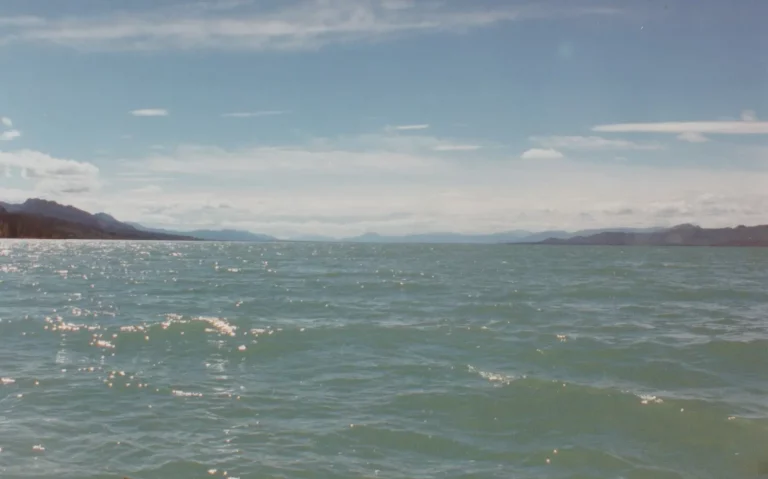
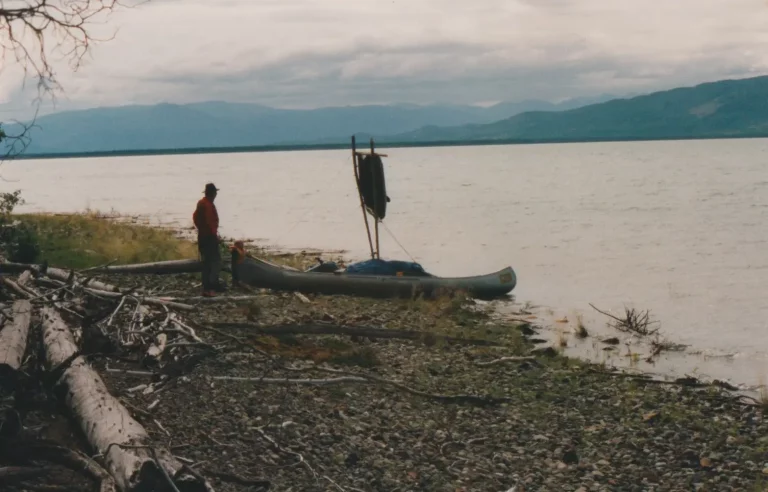
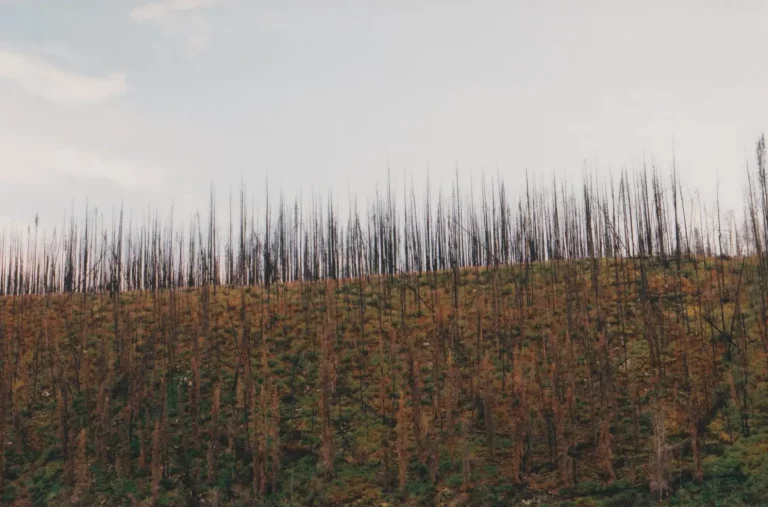
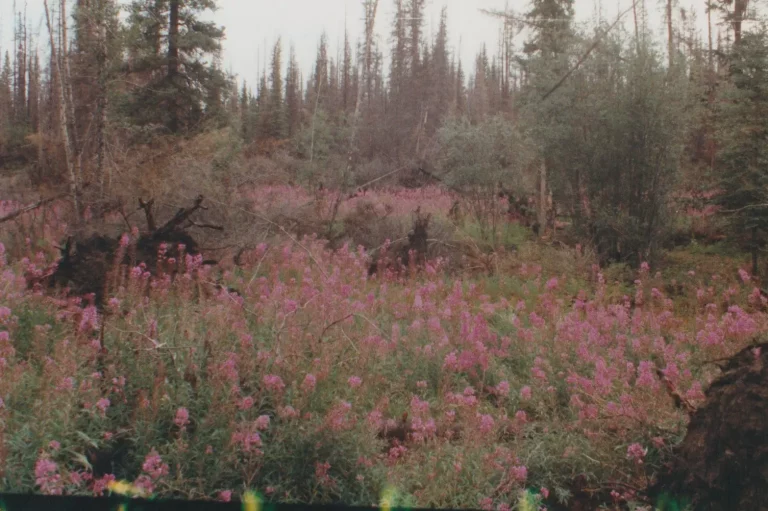
We pass various sights and see bald eagles, black bears and many other animals as we silently come around a bend in the river in the canoe.
There are also many forest fire areas where fireweed is now providing new life.
After 7 days we reach Carmacks, where we can replenish our supplies and have a few beers in the pub in the evening. One night later, the tour continues downstream on the Yukon.
The days on the river consist of 5-7 hours of canoeing, fishing, setting up and taking down the tent and preparing food – that’s all we need.
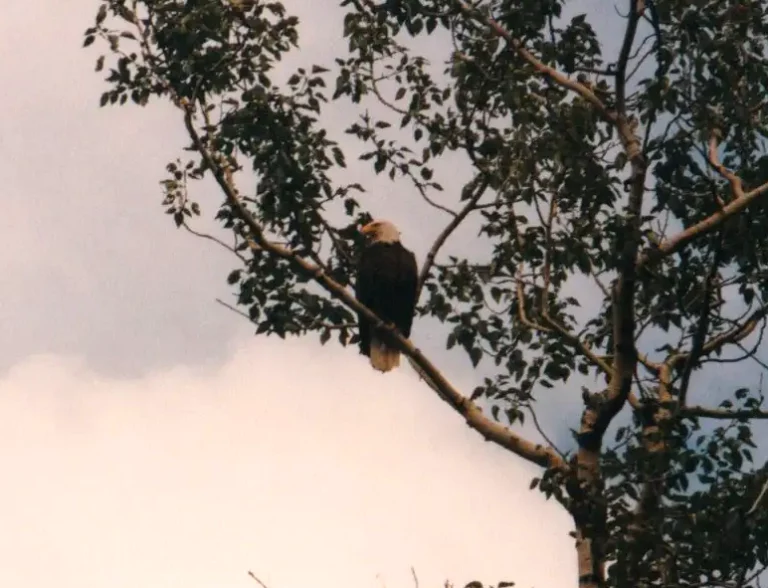
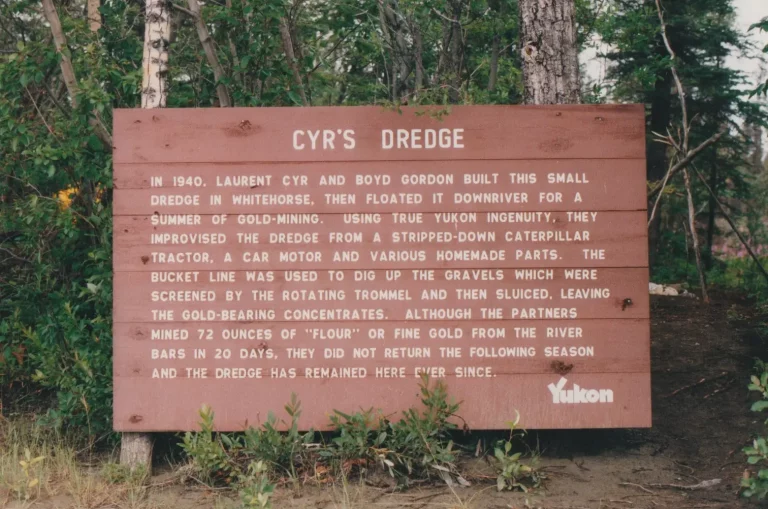
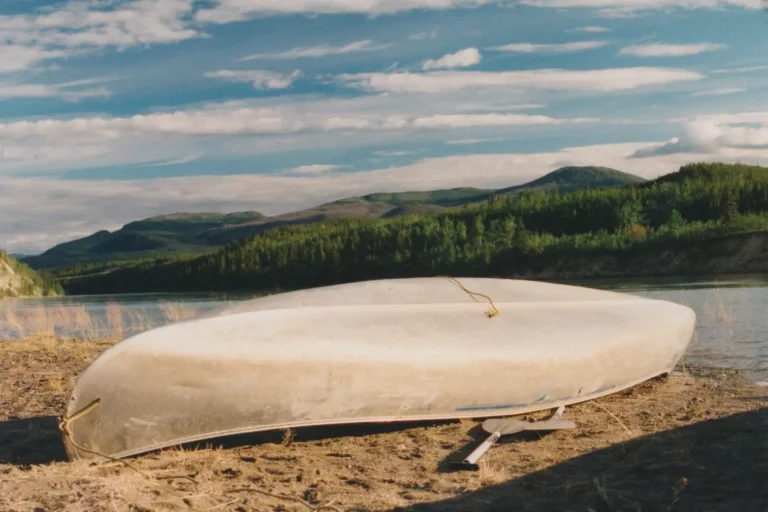
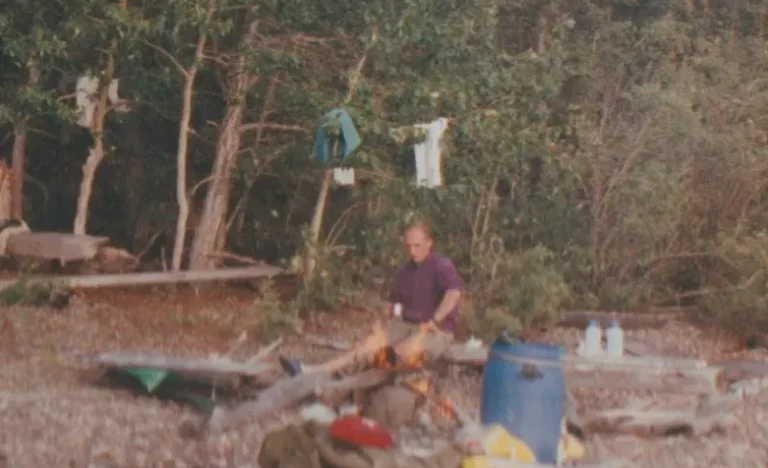
The Yukon now has a strong current and we are making rapid progress.
When ashoring we have to look around more and more often for suitable places and ashore against the current – otherwise it becomes dangerous – capsizing would be life-threatening in this wilderness.
To be on the safe side, we always strapped on our survival pack when canoeing so that we could at least build a fire and go fishing in the event of a capsize.
We usually camp on gravel banks, where it is easiest to ashore.
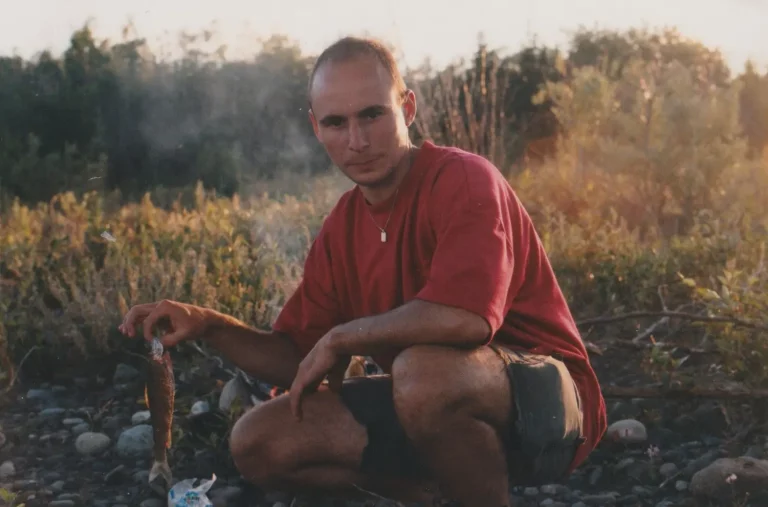
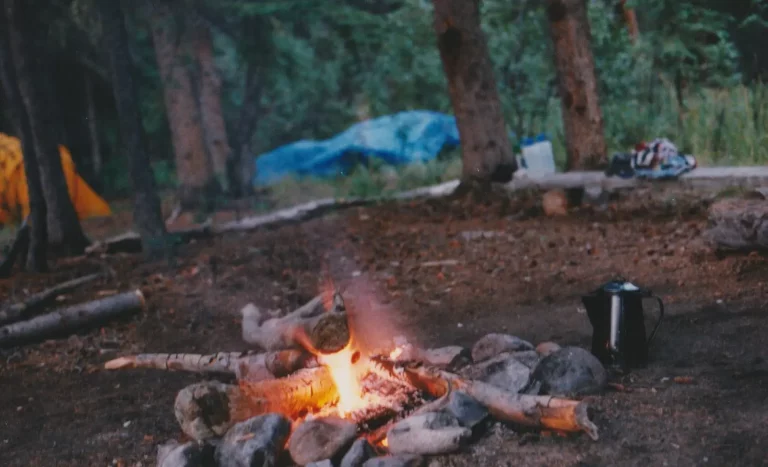
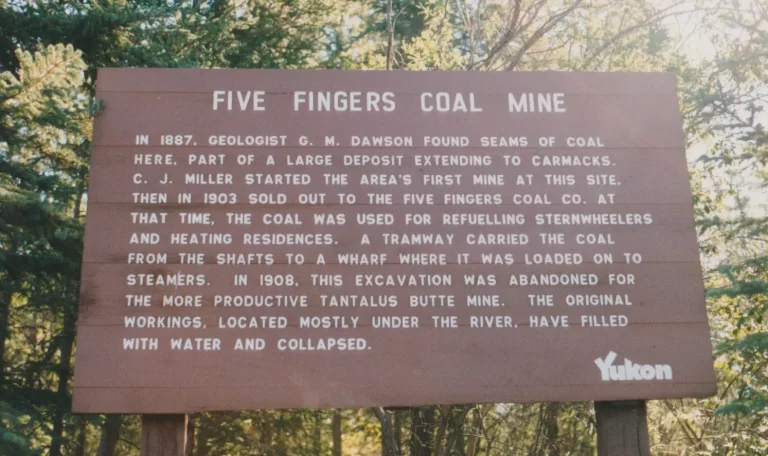
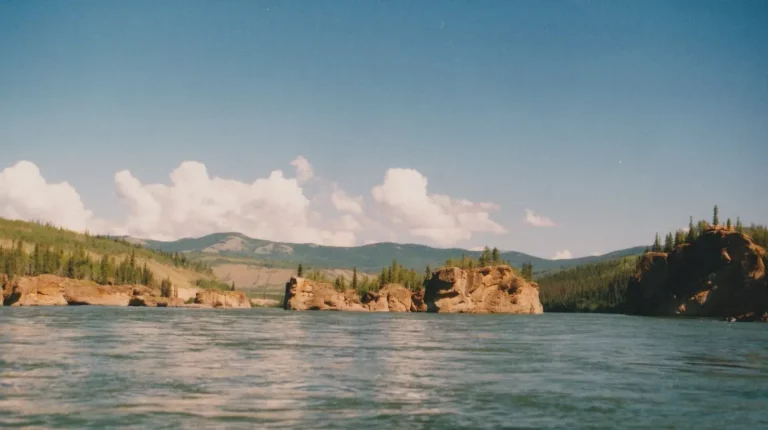
The big challenge on the Yukon are the rapids of the Five Fingers, where the river has to squeeze through four rocks at high speed. This is where many gold diggers lost their belongings on their rafts 100 years ago.
Before passing through we stop and look at the current from above. After tying up our luggage again, we drive towards the Five Fingers.
The right passage seems to be the cheapest, and so we rush through the rapids – Thomas sits in front and has the camera ready, and I sit in the back and steer our canoe into the current.
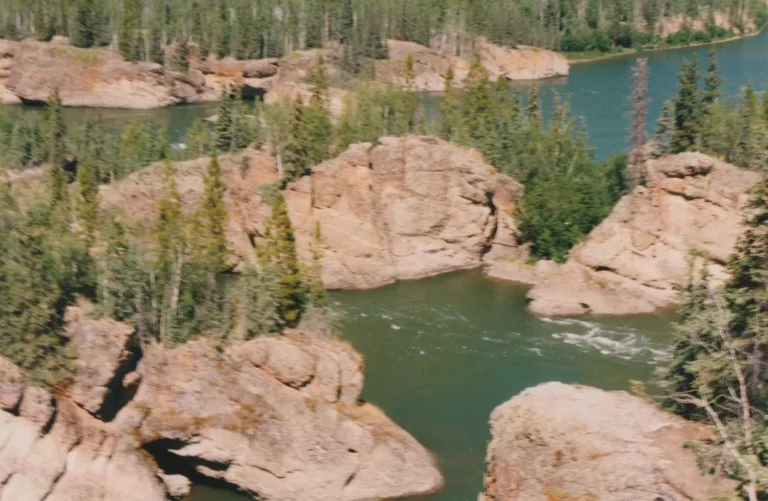
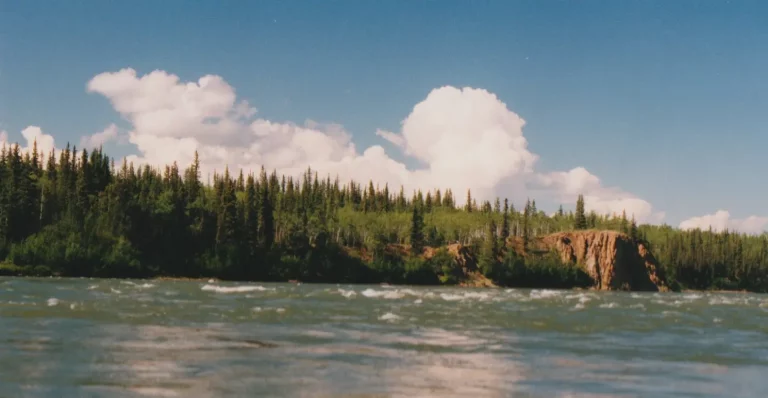
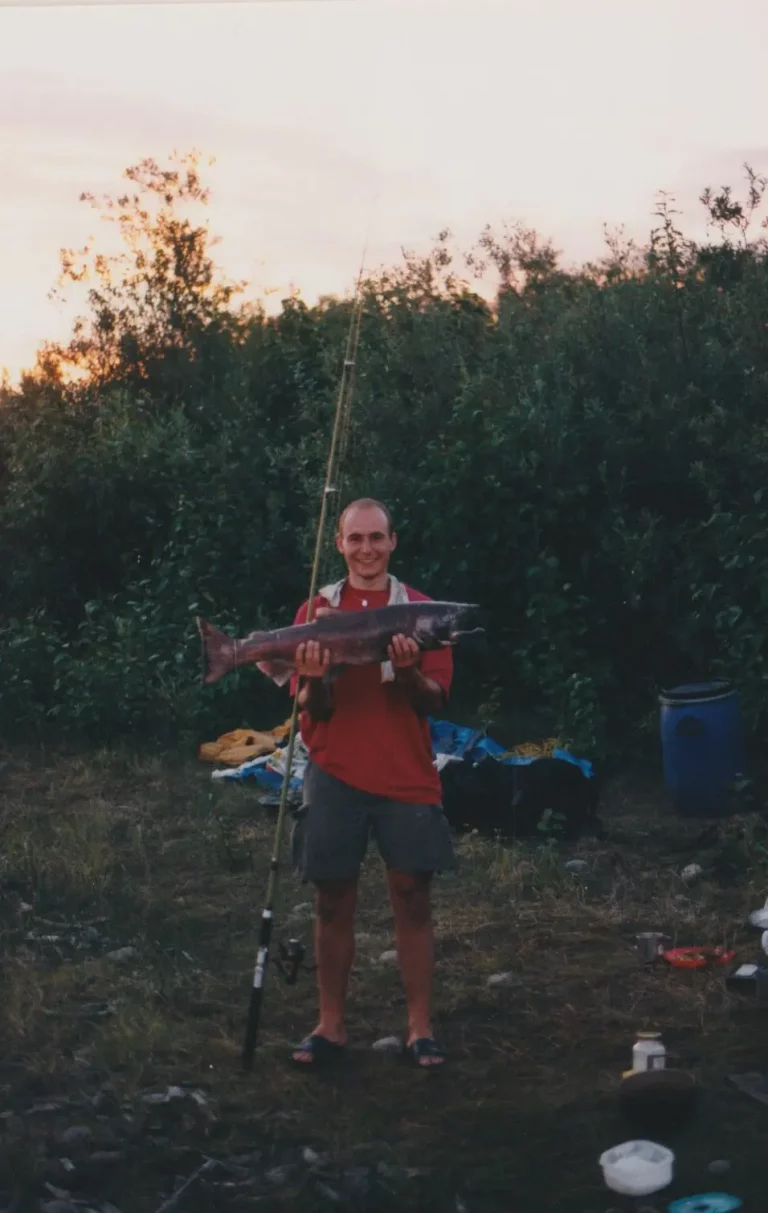
We manage to keep our canoe in the middle of the current and after a short jolting in the waves with spray and great noise, we shoot out into calm waters. All went well.
A few days later we celebrate our tour with a wonderful wild salmon that we – not caught ourselves as shown in the photo – but bought from local fishermen for 20 dollars.
We haven’t had such a great meal in a long time.
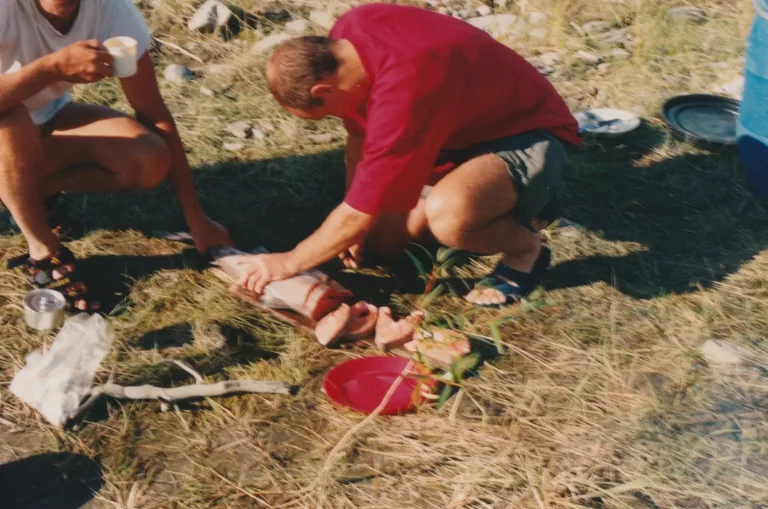
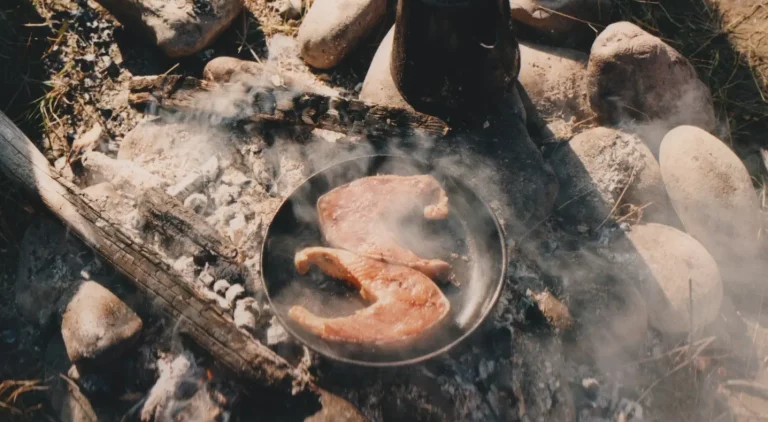
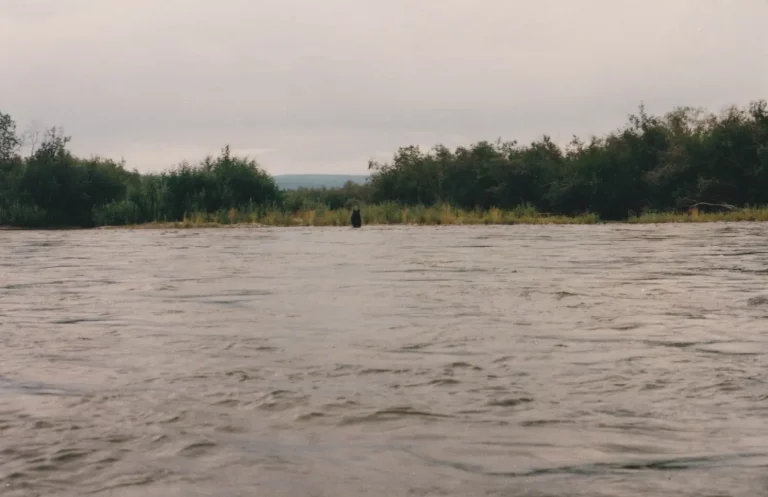
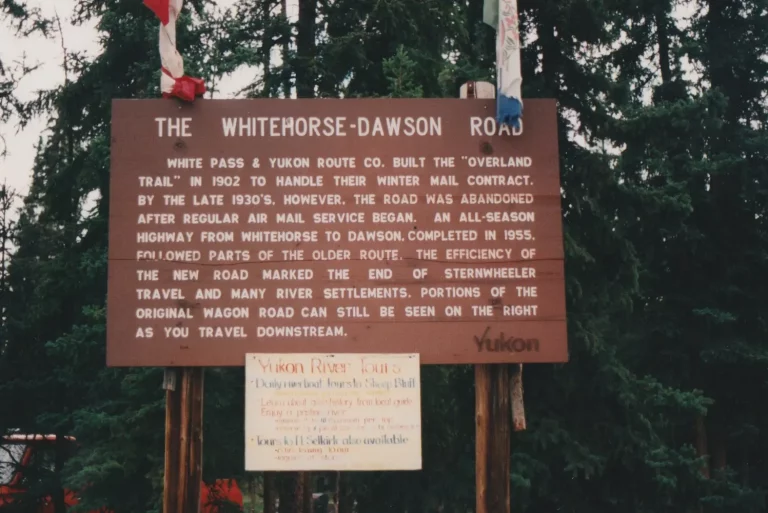
On the other bank of the river, a black bear also smelled our grilled salmon and looks over curiously.
So after the meal we decide to drive a few kilometers further downstream and set up camp there – not that the bear comes up with the idea of swimming over and visiting us.
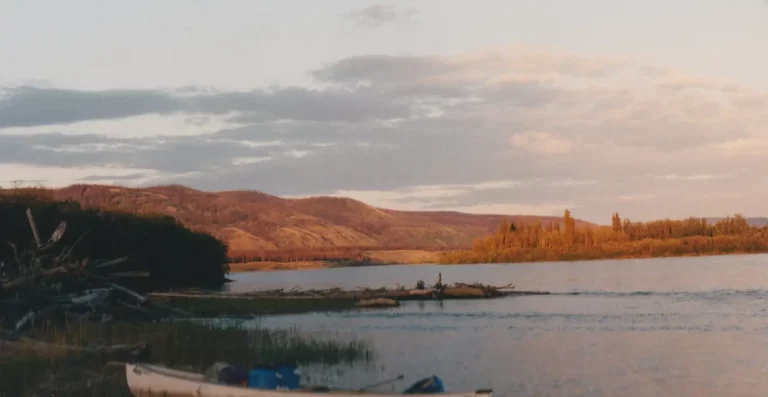
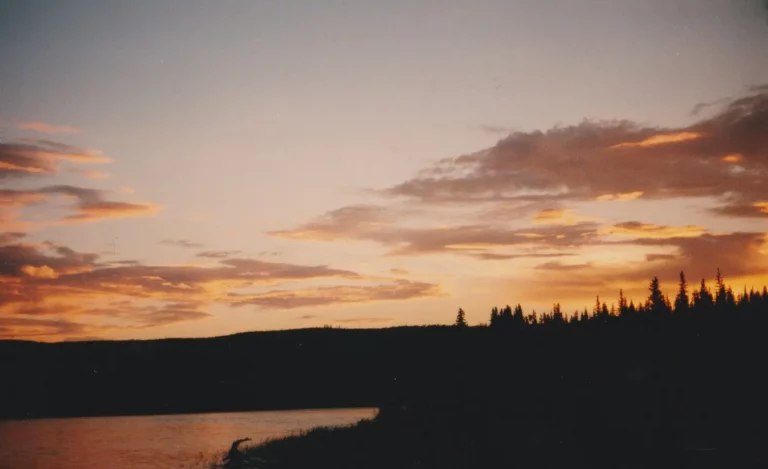
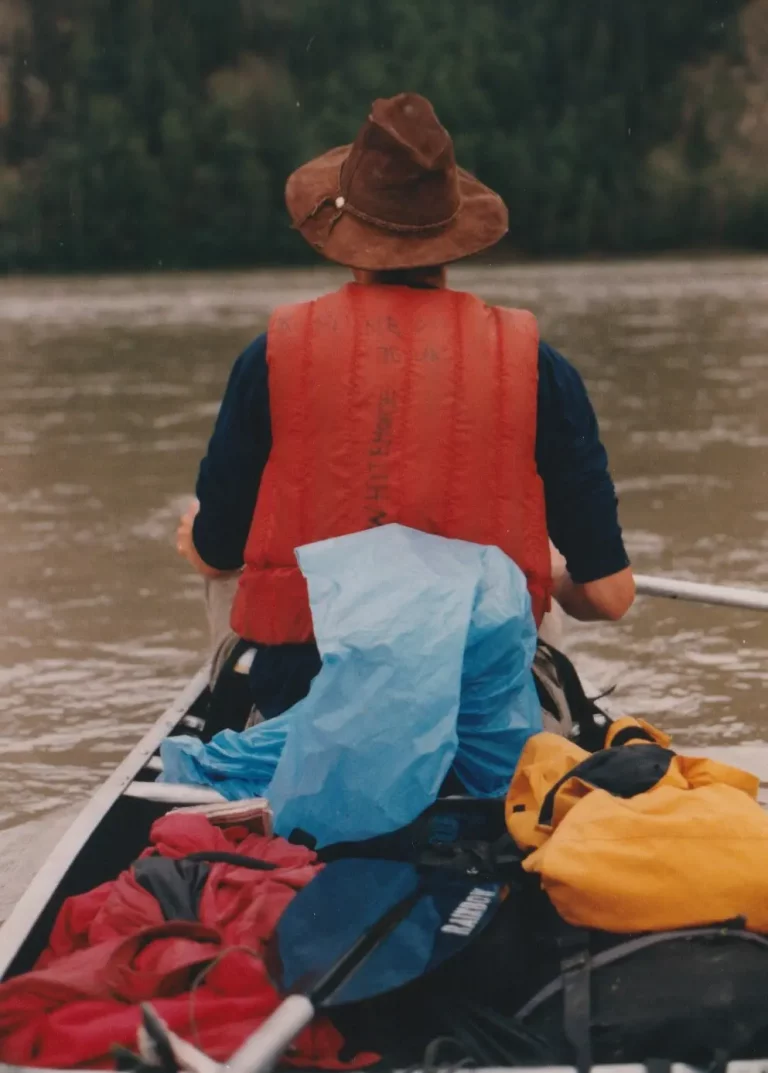
So we spend the days in the sun and sometimes in the rain fishing, camping and canoeing.
We get our drinking water from small streams that flow into the Yukon.
We also have Micropur disinfection tablets with us in case we need to drink water whose quality we are not sure about.
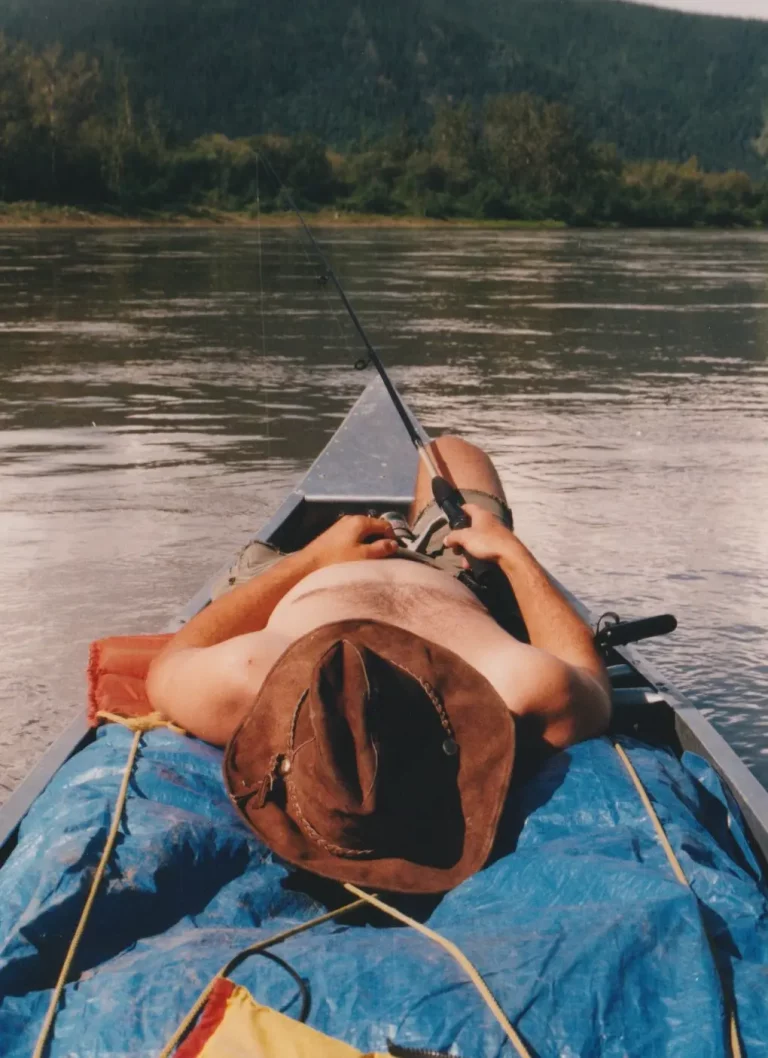
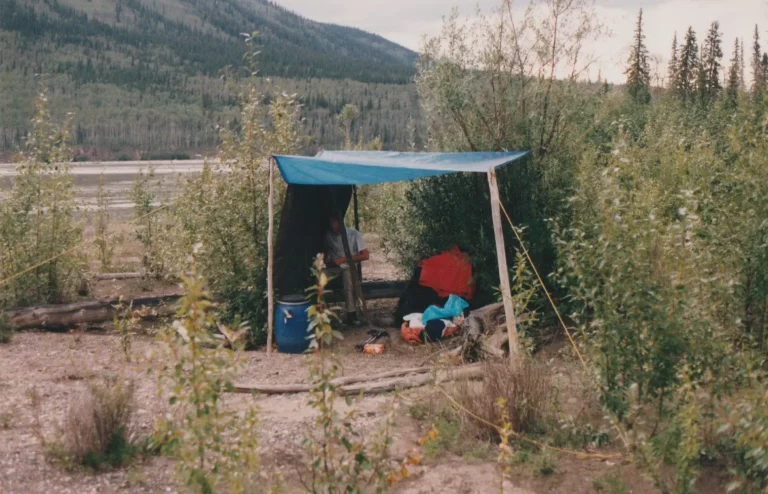
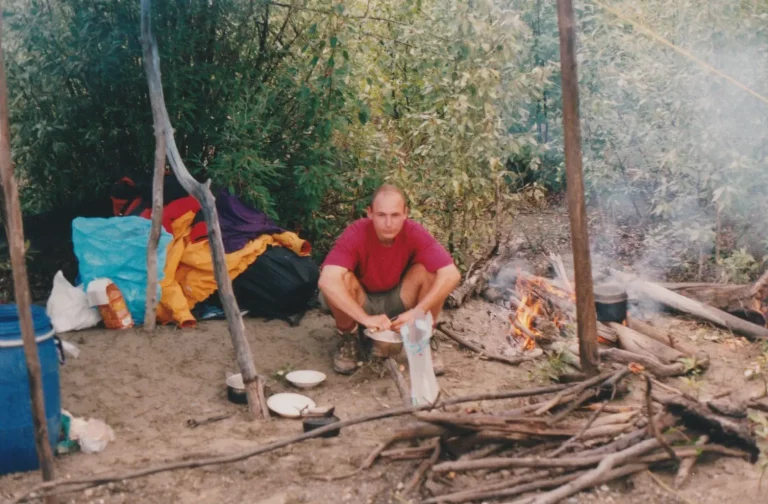
We have no problems catching fish when fishing – grayling in particular like to bite in the Yukon.
In between we also bake a pan bread (Bannok) which tastes wonderful with our grilled fish.
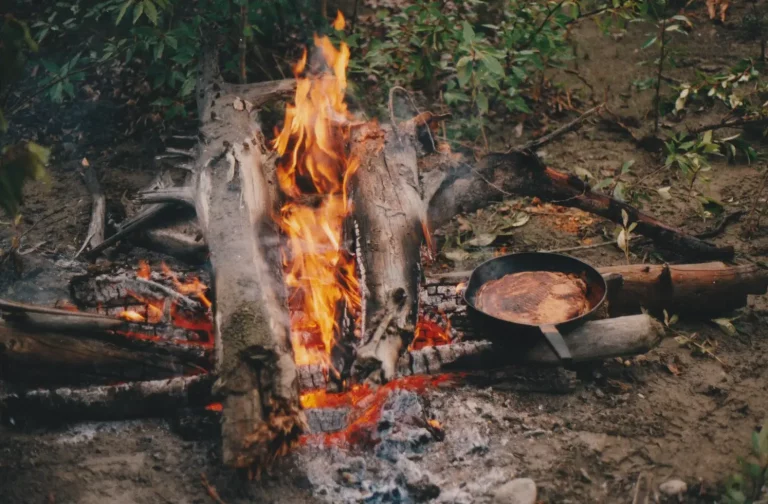
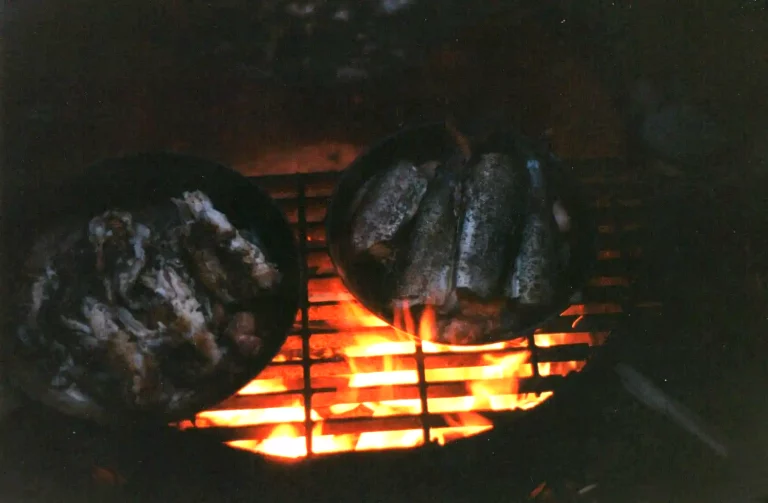
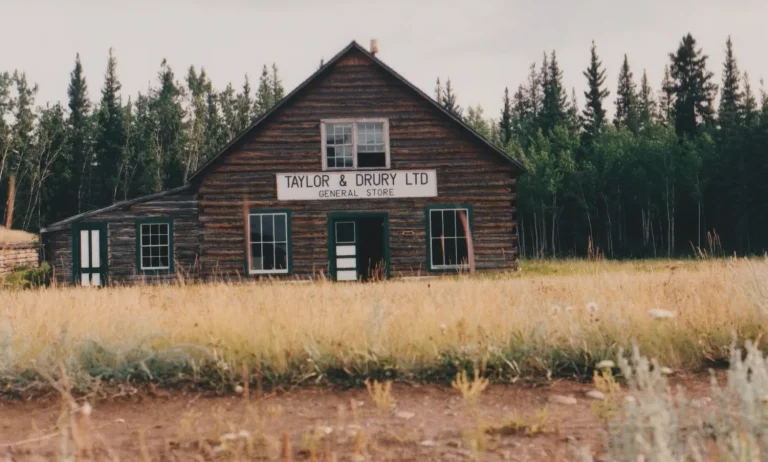
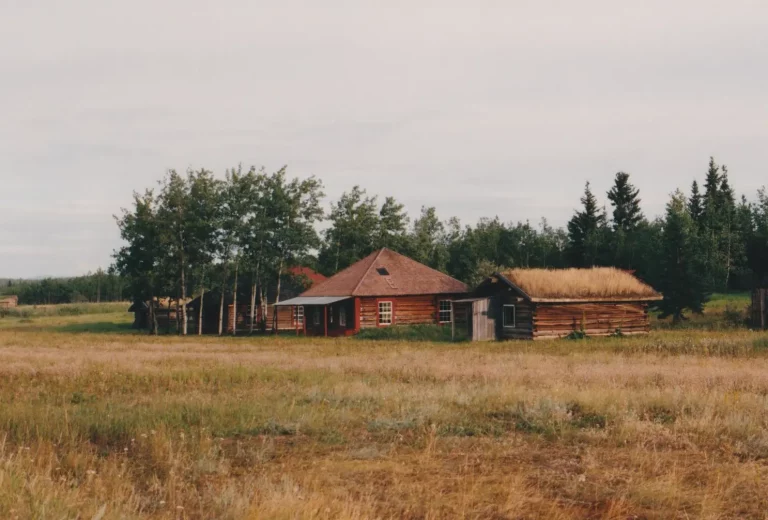
Via Fort Selkirk we come to join the White River, where the Yukon once again increases in size and current.
In the mouths of small streams and rivers you can sometimes see the gold (or perhaps fool’s gold) lying at the bottom.
When the sun shines into the water at a suitable angle, the entire riverbed glitters golden.
So the gold mining areas can’t be far away and after 18 days on the river we finally reach Dawson City – the destination of our canoe trip.
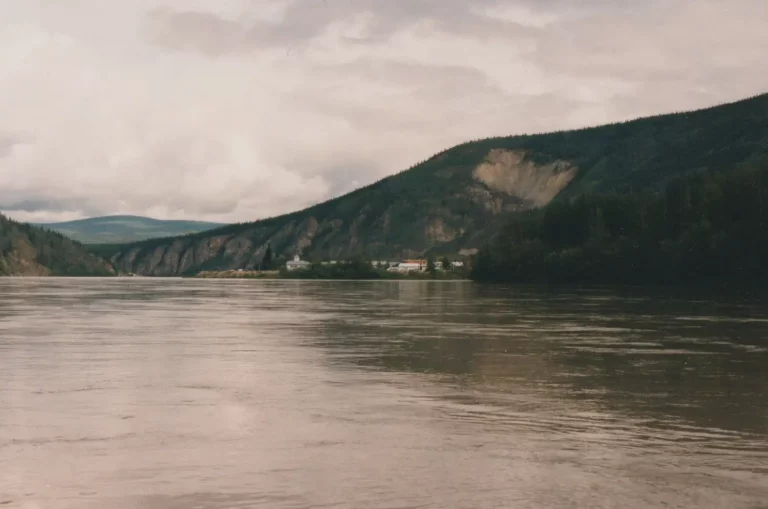
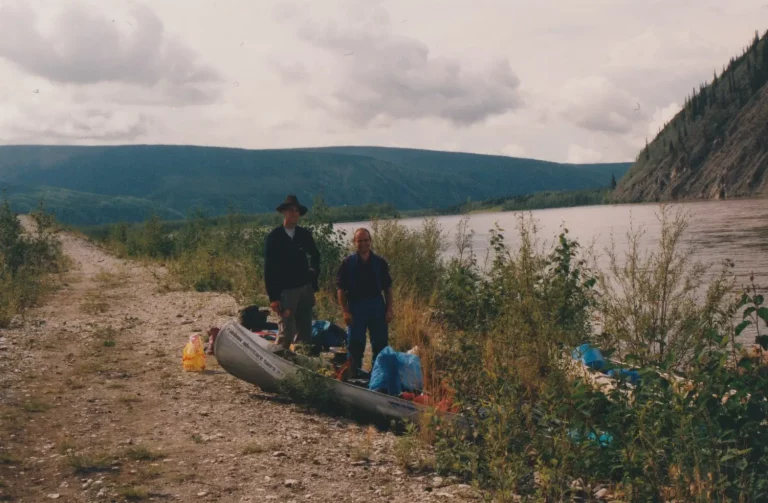
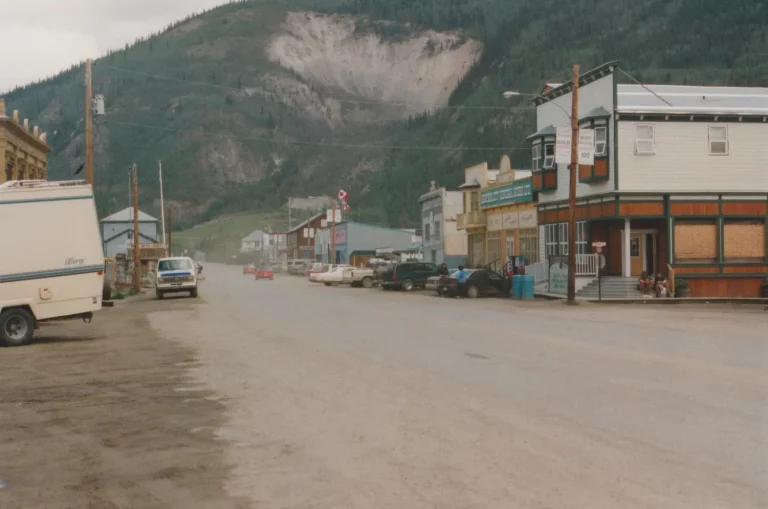
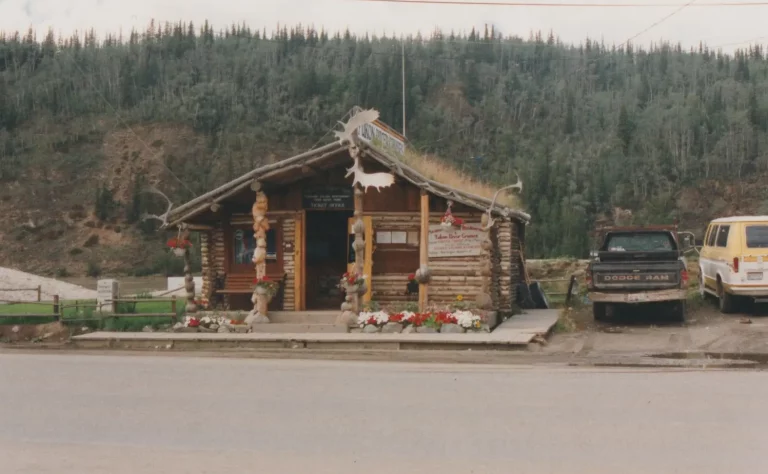
In Dawson City we first hand over our canoe to the rental service and now have to carry our backpacks ourselves – we have almost forgotten how heavy they are.
Dawson is a very rustic settlement in rough nature. Jack London also lived here during the gold rush and we also visited his hut – now a monument.
We spend 3 days in Dawson until we have clarified our onward journey. We plan to take the speedboat to Eagle in Alaska and from there fly to Fairbanks.
For the days in Dawson we book a cabin in the Dawson City River Hostel – so we can recondition our equipment and air out the sleeping bags.
The hostel is on the other bank of the Yukon and so we always have to cross the river by ferry to get to the city.
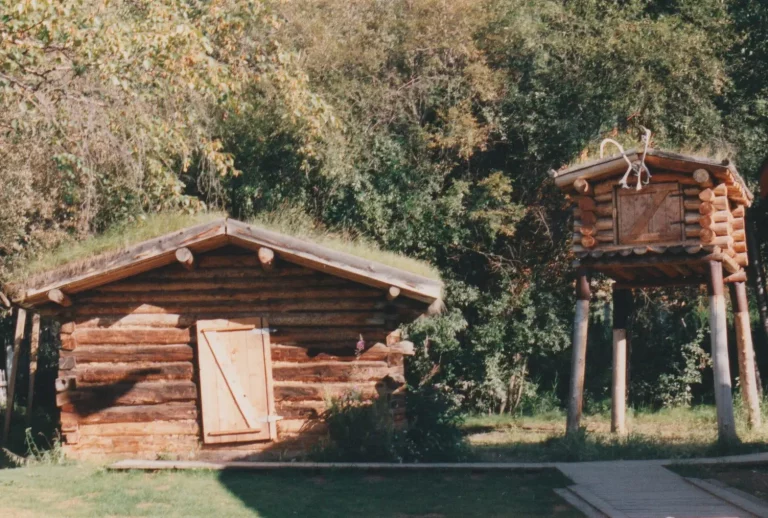
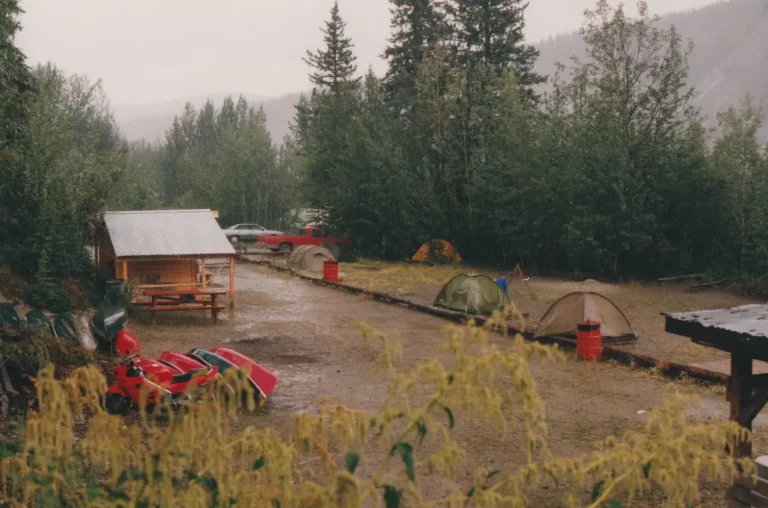
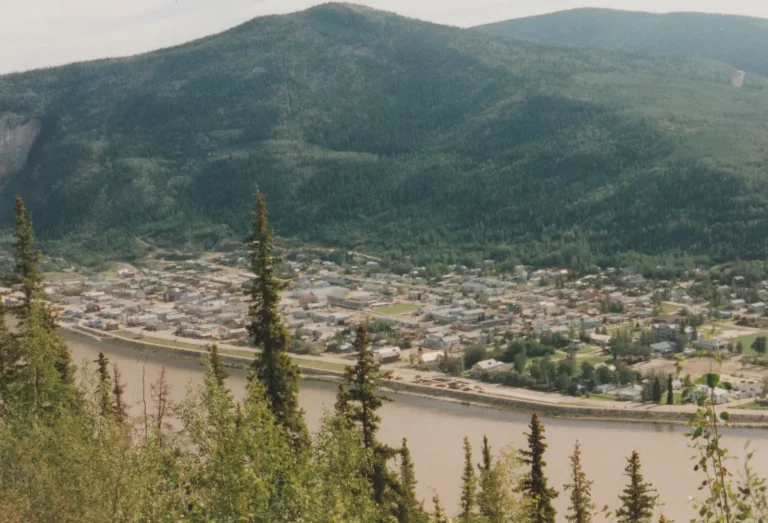
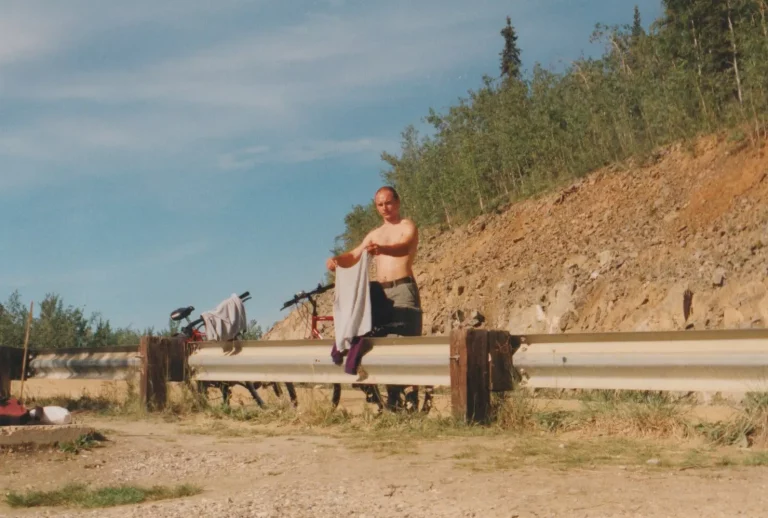
The owner of the hostel is Dieter Reinmuth, a – how could it be otherwise – german who emigrated from Kiel in 1992.
We rent two mountain bikes from Dieter, which we use to visit the Dawson area for a day. The trip to the “Dome” – the summit above Dawson – is particularly challenging.
In the best weather we fight our way up the mountain to enjoy the most beautiful view down to Dawson and back to the Yukon.
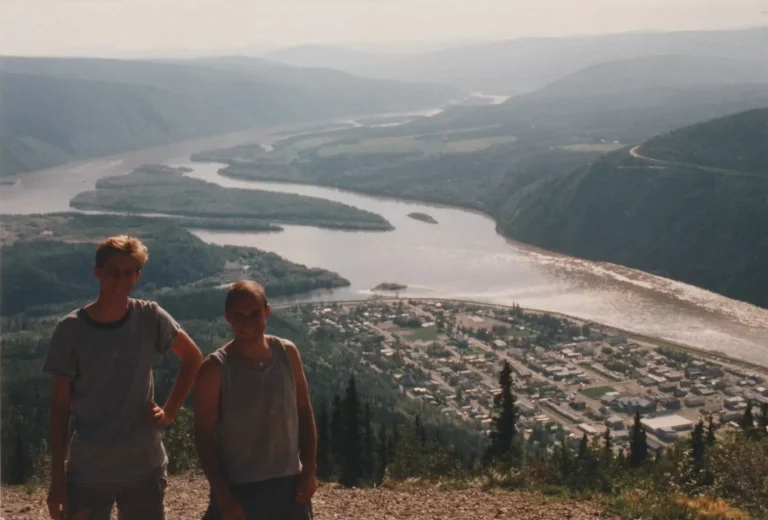
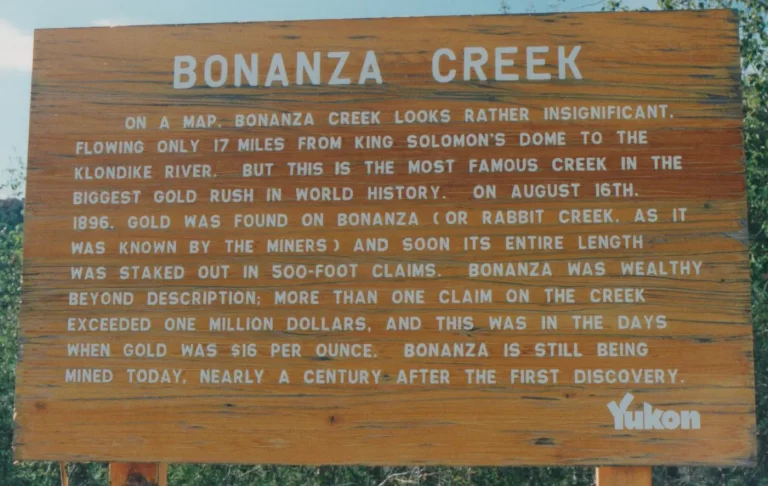
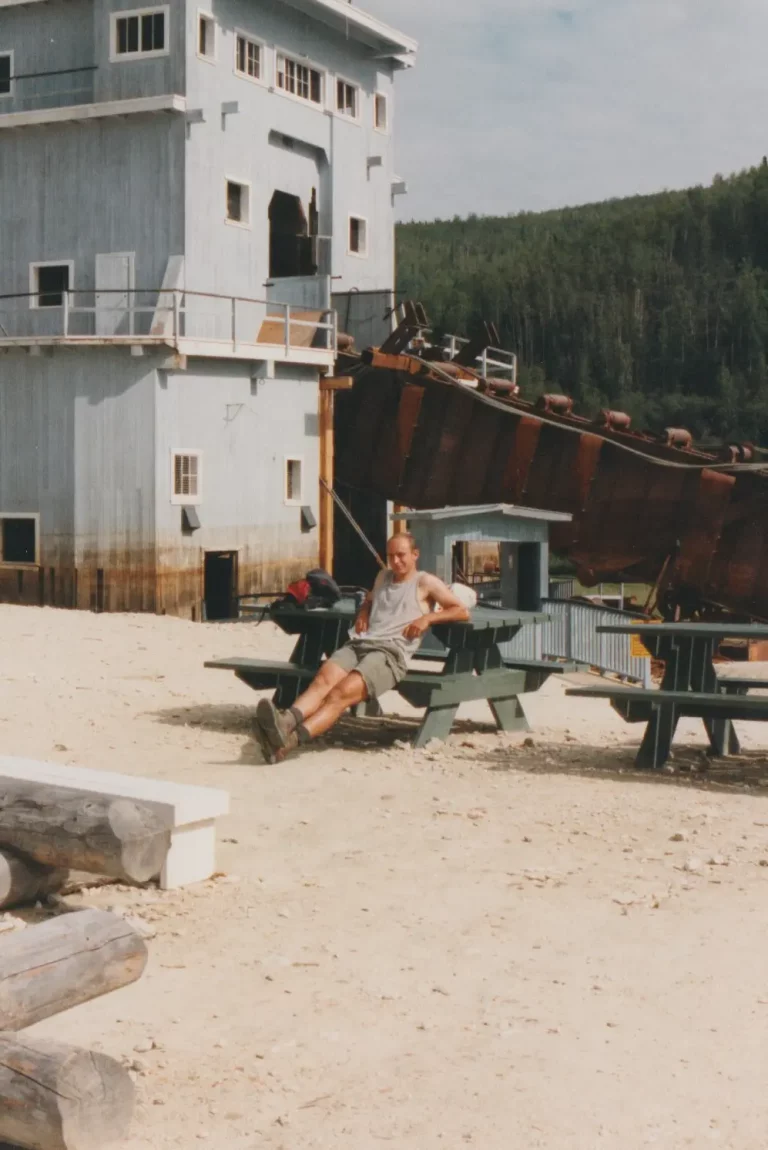
After a short break, we drive up the Klondike into the gold mining areas and visit the “Dredge No. 4” – a listed gold dredger that was in use in the 1940s.
On the morning of our onward journey, we almost missed our speedboat to Eagle because we didn’t include the ferry ride from the hostel to Dawson in our schedule.
It was only thanks to Thomas’s fast sprinting – with a weight of 29kg on his back – that the speedboat captain waited for us and took us to Eagle.
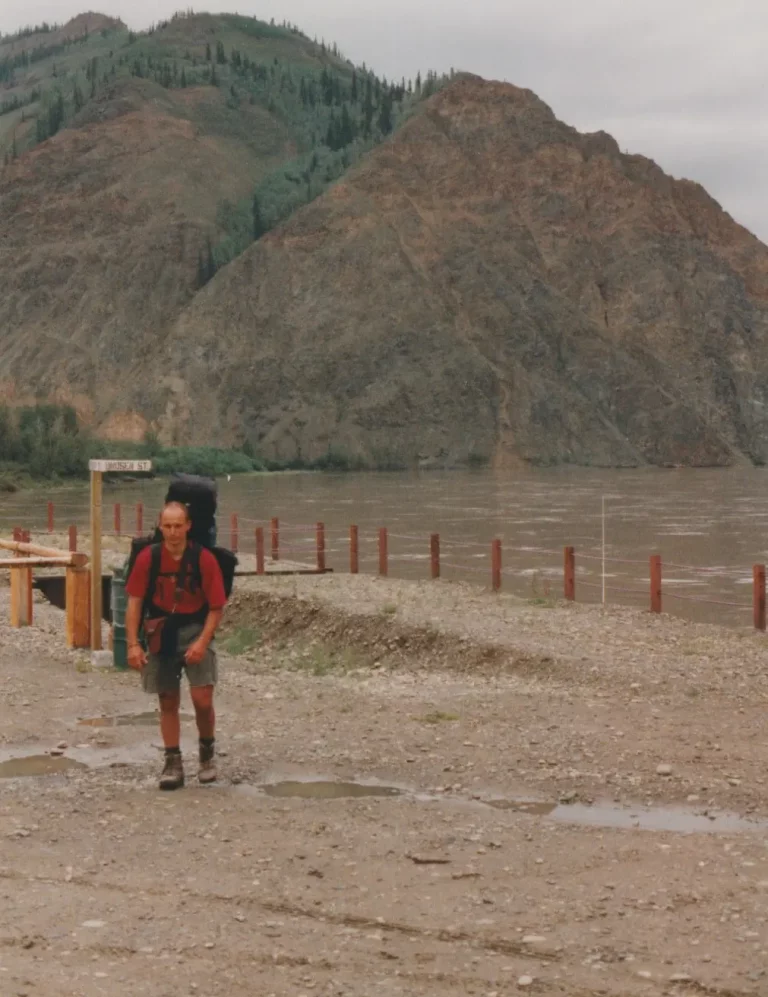
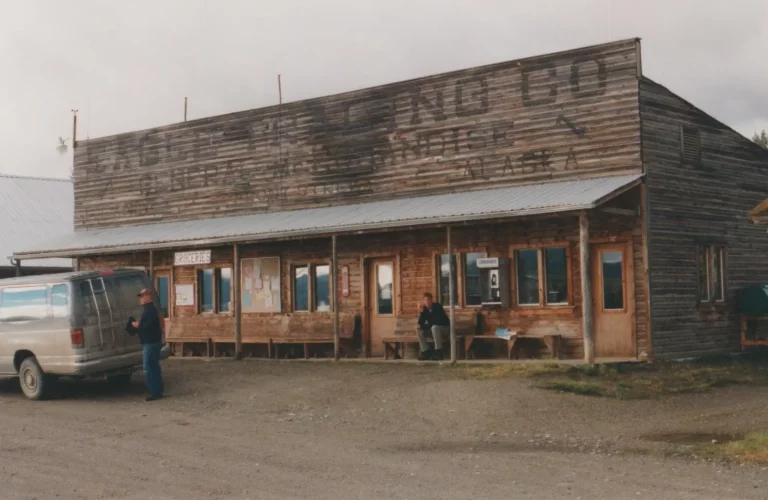
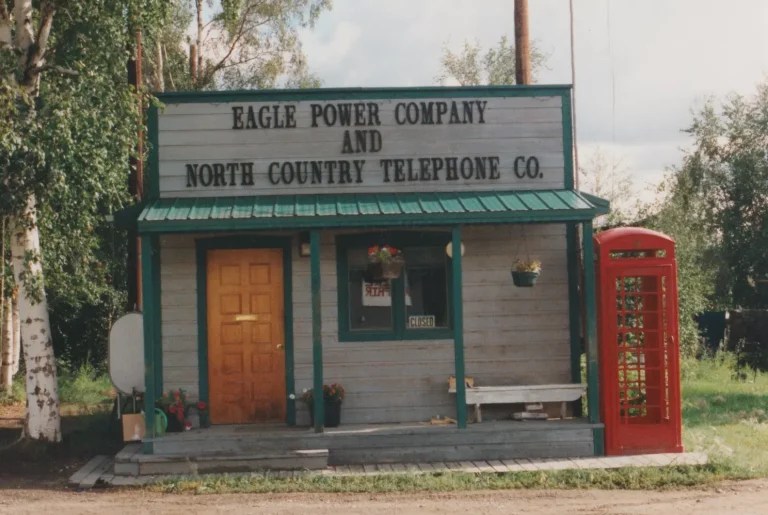
Eagle is an even smaller town than Dawson, but it has everything a border town between two states needs – gas station, post office, customs office, airport, travel agency, shops – all in one building and run by the same person!
Here we enter the USA again from Canada and get our passport stamped. We spend the night in a tent on the outskirts of town before taking off the next day in a single-engine plane towards Fairbanks.
A final look back from above shows how small Eagle actually is.
Thomas is not very fit to fly that day and it takes a lot of effort for him to survive the 2-hour flight without having to use the emergency bags.
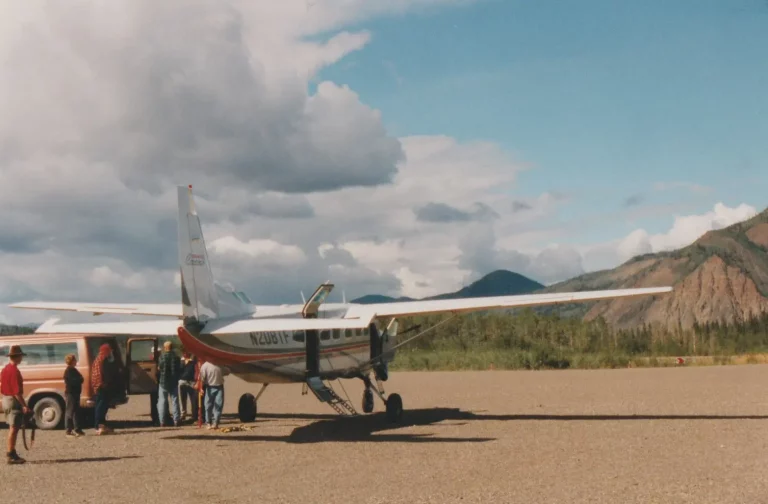
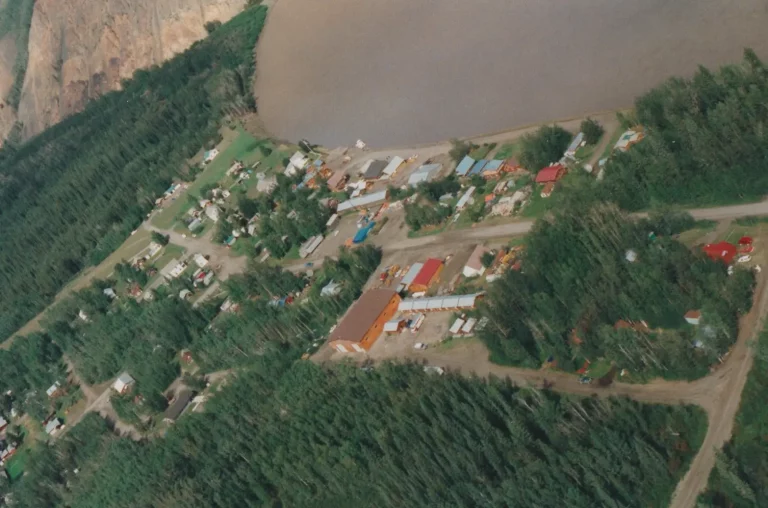
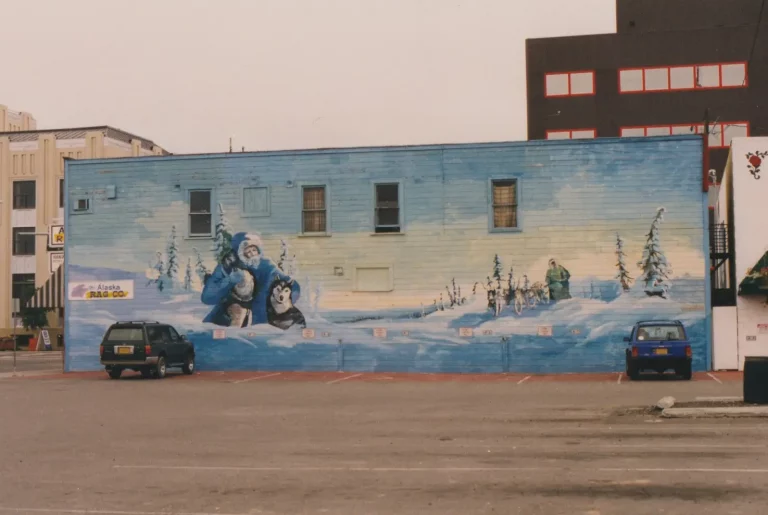
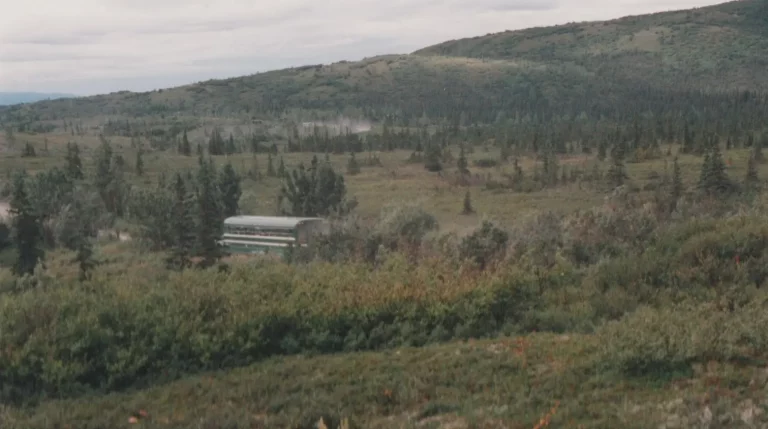
We stay in Fairbanks for another two nights to book a bus trip to Denali National Park.
The approximately 3-hour drive there, in a small and overcrowded 9-seater Chevrolet, is tedious, but we’re used to a lot by now and so we arrive at Denali National Park in a good mood.
Since Denail Park is divided into different areas where the number of hikers is strictly limited, we choose the furthest area – and closest to Denali – south of Wonder Lake. There aren’t many hikers there yet.
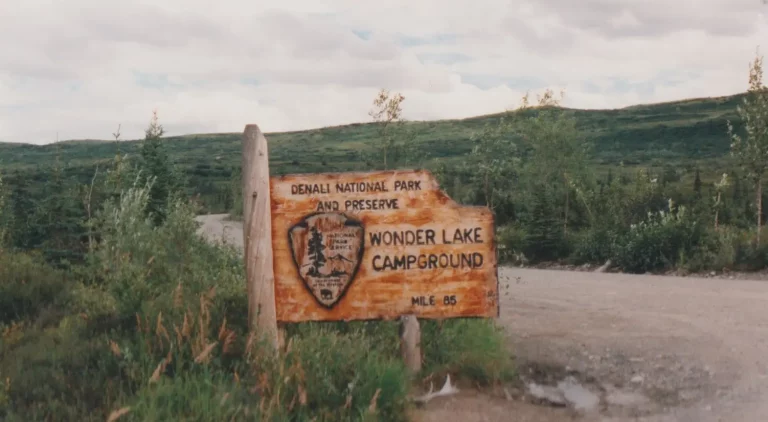
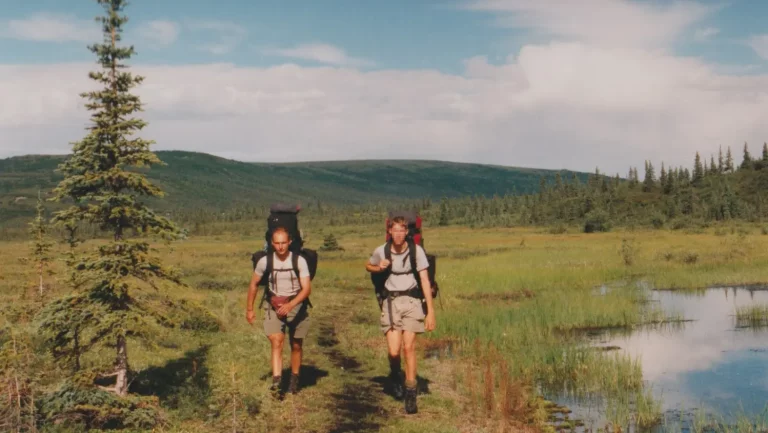
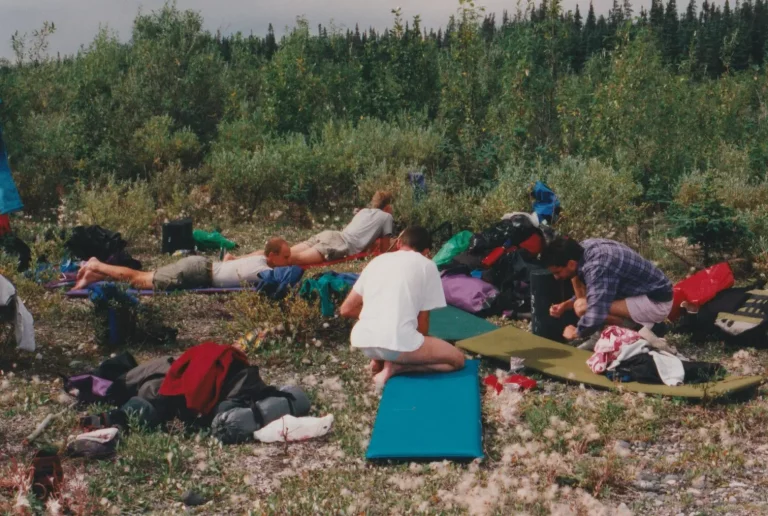
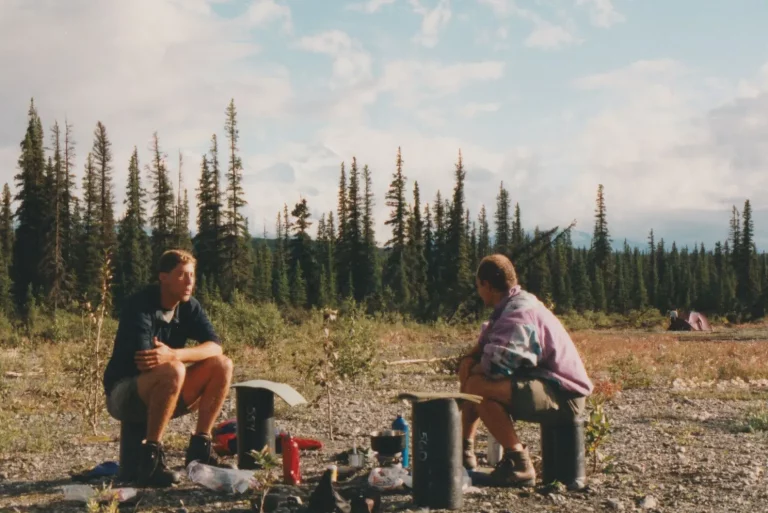
On the bus ride to Wonderlake – what else – we meet a group of 4 mountaineers from Munich who are also traveling in this area.
So we form a group together that goes into the wilderness to Denali.
Our first destination is to cross the McKinley River, about a day’s walk away. So we set up camp together before we dare to cross the next day.
The mandatory bear-safe food containers add an additional 3kg of weight, but are ideal as a camping chair.
A porcupine comes to visit us in the camp, but after briefly clarifying the situation, it retreats back into the bush.
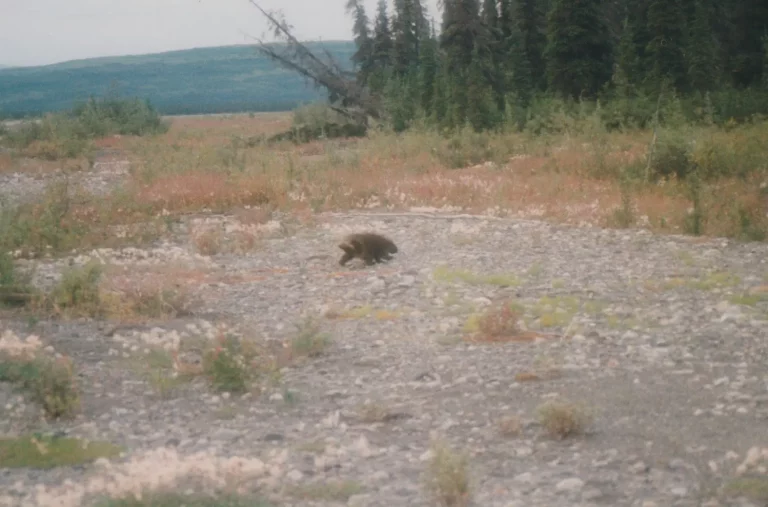
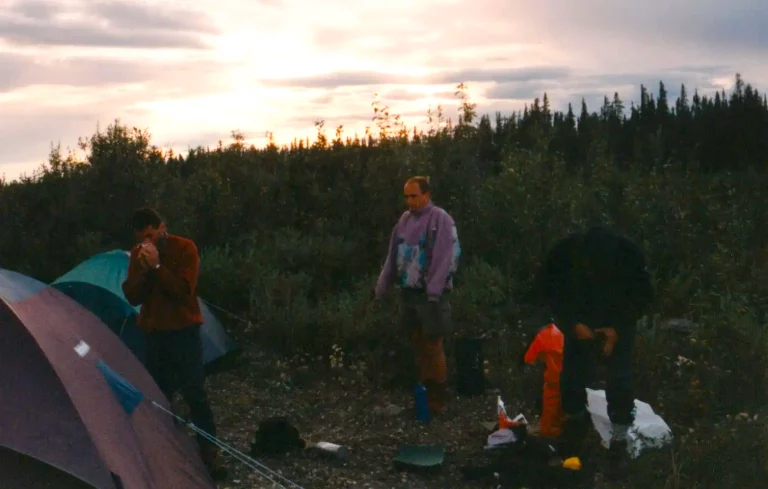
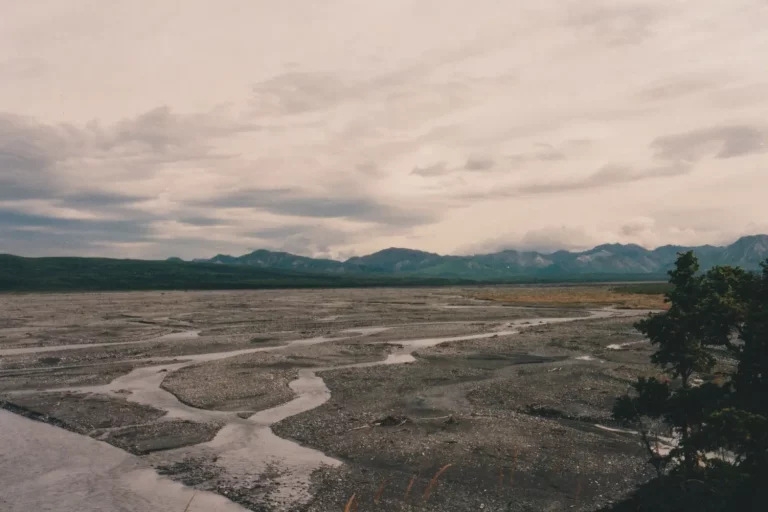
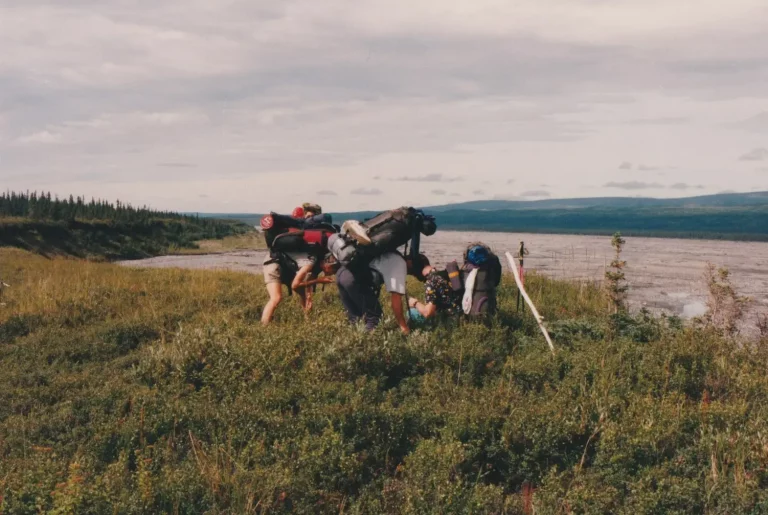
It turns out that crossing the McKinley River in a group has great advantages, as there are sometimes strong currents in the various branches of the river, and crossing in a group is much easier than alone.
On the other side of the river there are an incredible number of blueberry bushes with the sweetest and juiciest blueberries we have ever tasted. So everyone spends a lot of time picking and snacking.
The bushes, some of which have grown to chest height, do not make hiking easy. We follow the game trails of the caribou and bears that make their home in this area.
Fresh excrement shows us that these animals also like to eat the blueberries here. So we always move loudly to avoid unexpected encounters with animals.
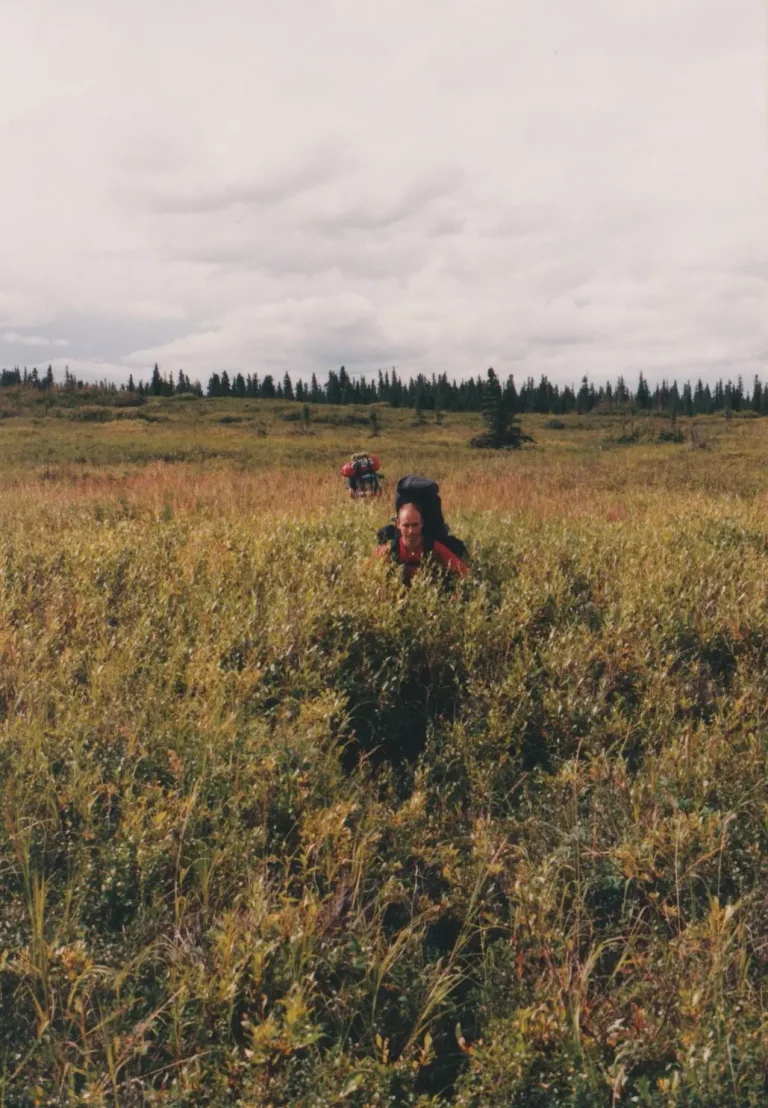
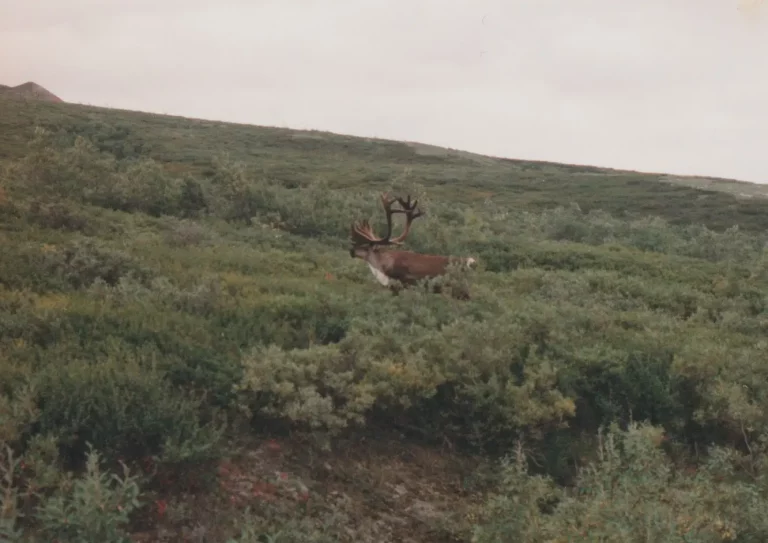
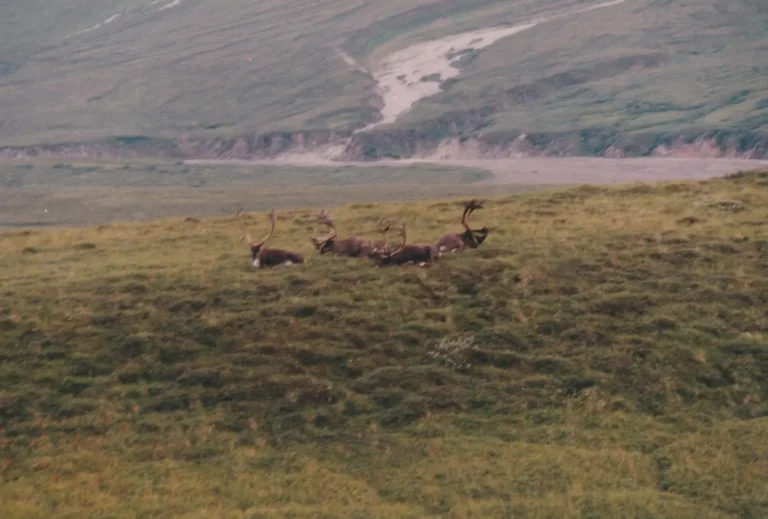
Luckily, we only see caribou and bears from a safe distance through our camera’s telephoto lens.
But the feeling of caution and mindfulness is constantly present. We definitely don’t want to meet in close proximity.
We always have our bear spray on hand, but we always hope that we never have to use it.
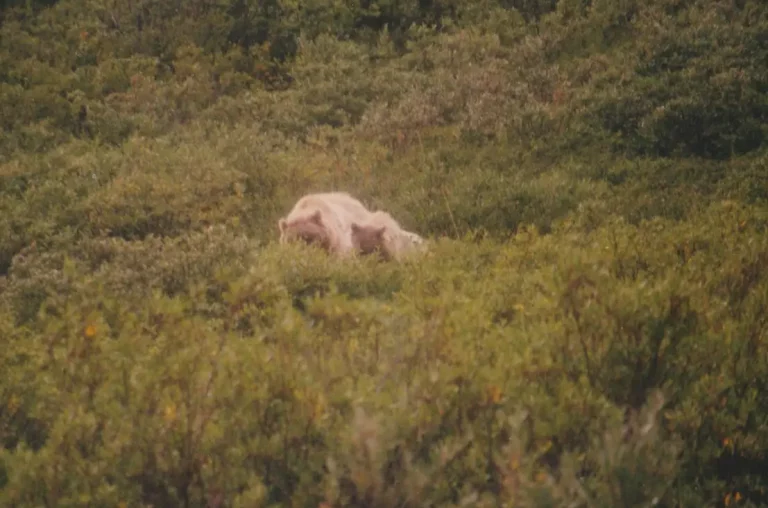
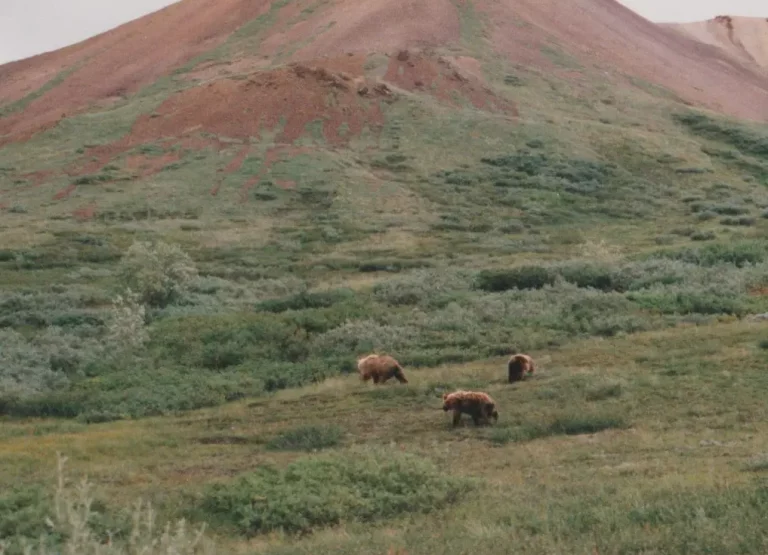
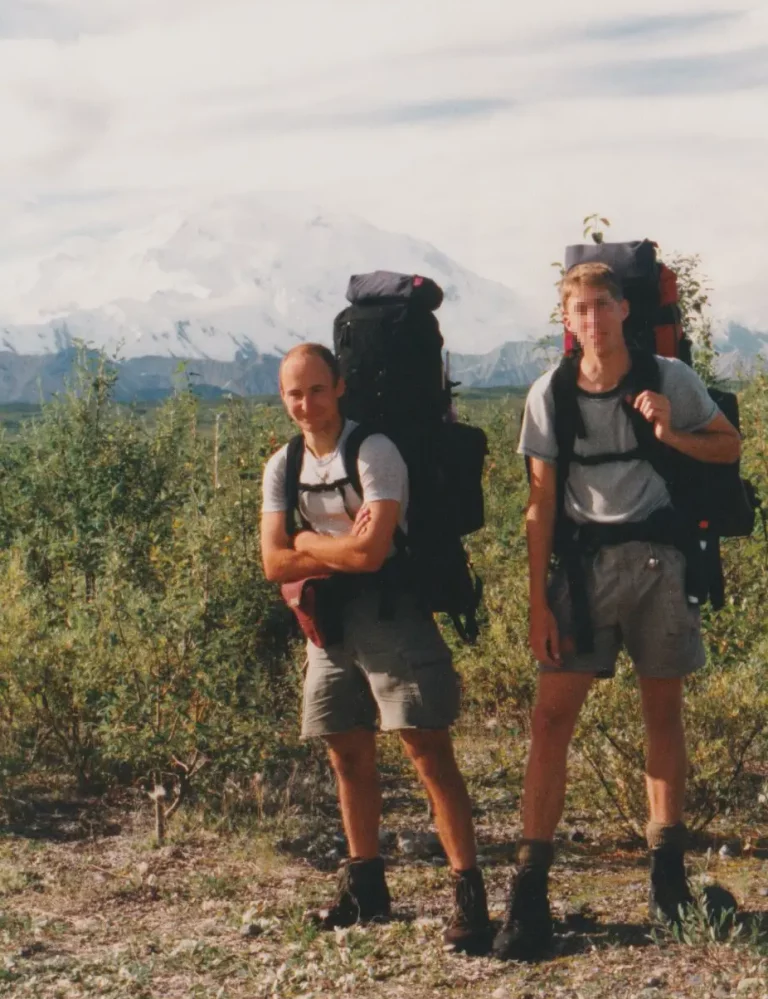
After another day’s walk towards Denali, we can already see the mountain range in all its glory – weather permitting.
It is often cloudy and the summit is shrouded in clouds and rarely seen.
So Thomas and I decide to set up camp on a riverbed and stay there for the next few days.
After 4 weeks of outdoor adventure, we no longer feel like going on further hikes through the blueberry jungle.
The Munich mountaineering group continues their hike towards Denali.
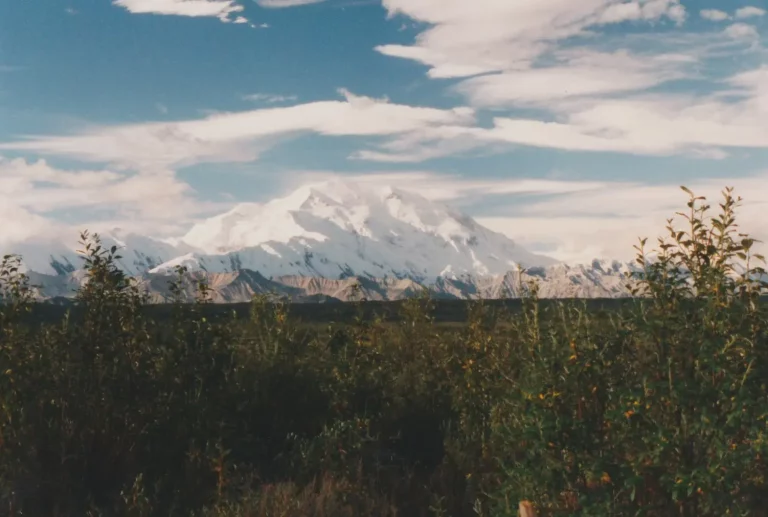
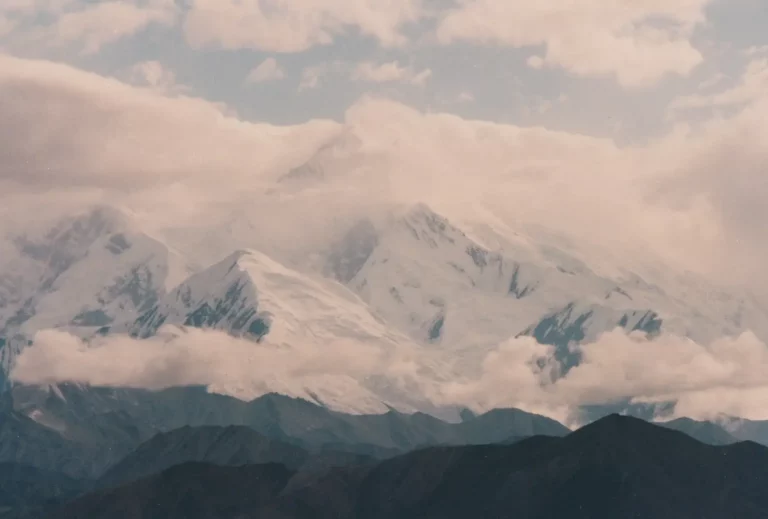
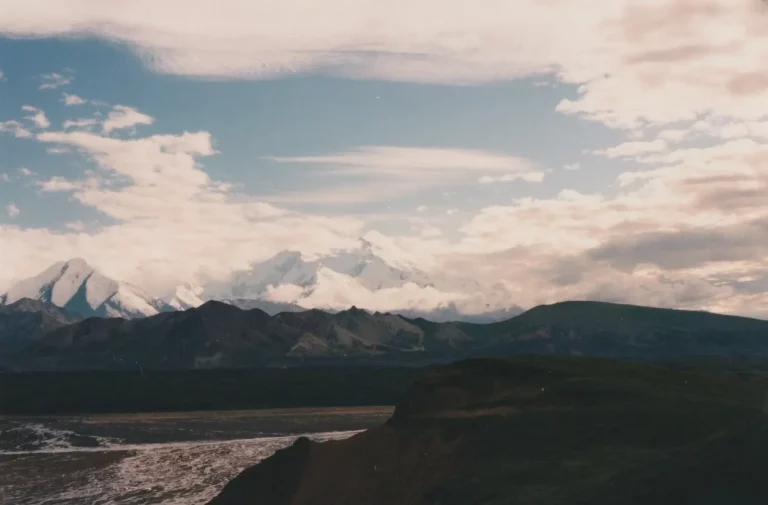
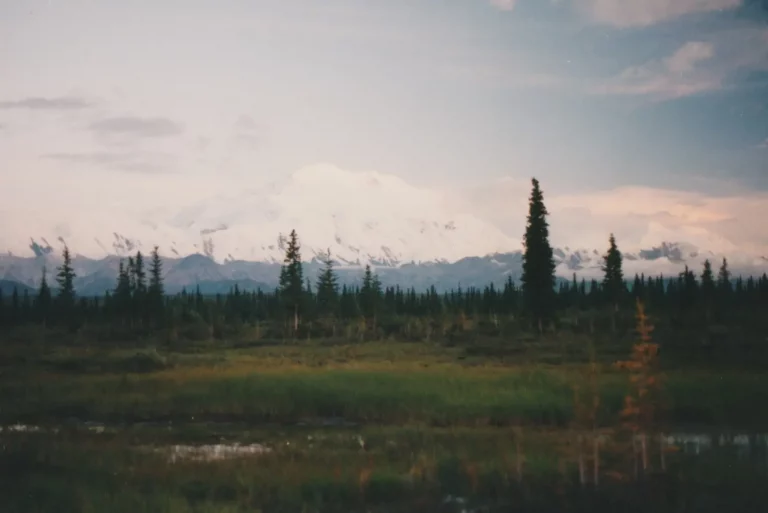
After 5 days we are back at Wonderlake and a day later we are on the bus to Anchorage.
In fact, the anticipation of a bed, a shower and a restaurant after these 5 weeks is huge.
In Anchorage we spend a few more days in the city and the surrounding area and enjoy the benefits of civilization before we fly back to Germany at the end of August 1997.
